Link to 2017-18 thread: https://flutrackers.com/forum/forum/...17-2018-season 2018-2019 Influenza Season Week 41 ending October 13, 2018
All data are preliminary and may change as more reports are received.
An overview of the CDC influenza surveillance system, including methodology and detailed descriptions of each data component, is available at http://www.cdc.gov/flu/weekly/overview.htm.,
Synopsis:
Influenza activity in the United States remains low. Influenza A(H1N1)pdm09, influenza A(H3N2), and influenza B viruses continue to co-circulate, with influenza A(H1N1)pdm09 viruses reported most commonly by public health laboratories during the most recent three weeks. The first influenza-associated pediatric death occurring during the 2018-2019 season was reported this week. Below is a summary of the key influenza indicators for the week ending October 13, 2018.
*https://www.hhs.gov/about/agencies/i...ces/index.html
? Elevated means the % of visits for ILI is at or above the national or region-specific baseline
? Includes all 50 states, the District of Columbia, Guam, Puerto Rico, and U.S. Virgin Islands
? National data are for current week; regional data are for the most recent three weeks
U.S. Virologic Surveillance:
WHO and NREVSS collaborating laboratories, which include both public health and clinical laboratories located in all 50 states, Puerto Rico, Guam, and the District of Columbia, report to CDC the total number of respiratory specimens tested for influenza and the number positive for influenza by virus type. In addition, public health laboratories also report the influenza A subtype (H1 or H3) and influenza B lineage information of the viruses they test and the age or age group of the persons from whom the specimens were collected.
Additional virologic data, including national, regional and select state-level data, can be found at: http://gis.cdc.gov/grasp/fluview/flu...dashboard.html. Age group proportions and totals by influenza subtype reported by public health laboratories can be found at: http://gis.cdc.gov/grasp/fluview/flu_by_age_virus.html.
The results of tests performed by clinical laboratories are summarized below.
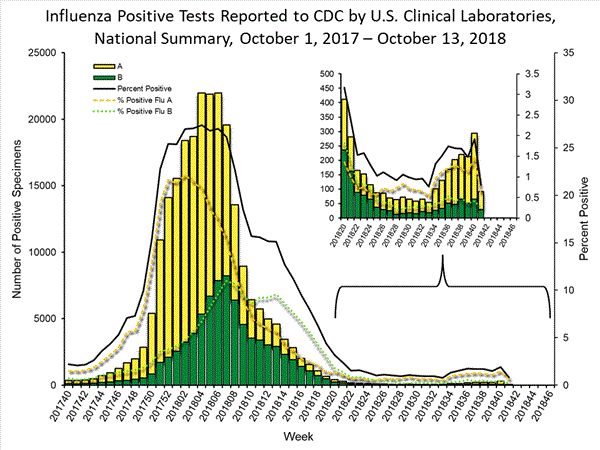
View National and Regional Level Graphs and Data | View Chart Data | View Full Screen | View PowerPoint Presentation
The results of tests performed by public health laboratories are summarized below.
*The percent of specimens testing positive for influenza is not reported because public health laboratories often receive samples that have already tested positive for influenza at a clinical laboratory and therefore percent positive would not be a valid indicator of influenza activity. Additional information is available at http://www.cdc.gov/flu/weekly/overview.htm.
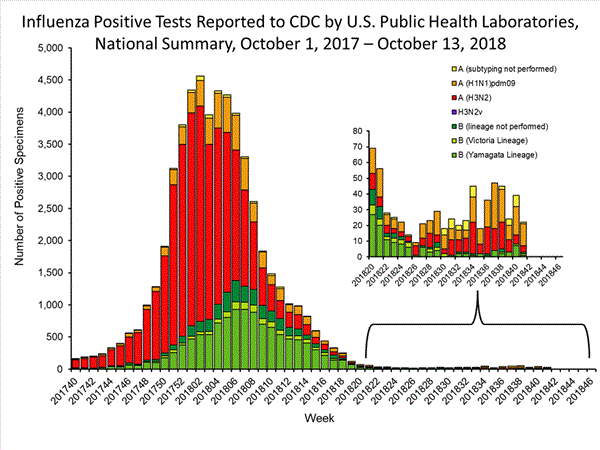
View National and Regional Level Graphs and Data | View Chart Data | View Full Screen | View PowerPoint Presentation
Influenza Virus Characterization:
Close monitoring of influenza viruses is required to better assess the potential impact on public health. CDC characterizes influenza viruses through one or more tests including genomic sequencing, hemagglutination inhibition (HI) and/or neutralization assays based Focus Reduction assays (FRA). These data are used to compare how similar currently circulating influenza viruses are to the reference viruses used for developing new influenza vaccines and to monitor evolutionary changes that continually occur in influenza viruses circulating in humans. Antigenic and genetic characterization of circulating influenza viruses gives an indication of the influenza vaccine's ability to induce an immune response against the wide array of influenza viruses that are co-circulating every season. However, annual vaccine effectiveness estimates are needed to determine how much protection was provided to the population by vaccination.
For nearly all influenza-positive surveillance samples received at CDC, next-generation sequencing is performed to determine the genetic identity of circulating influenza viruses and to monitor the evolutionary trajectory of viruses circulating in our population. Virus gene segments are classified into genetic clades/subclades based on phylogenetic analysis. However, genetic changes that classify the clades/subclades do not always result in antigenic changes. ?Antigenic drift? is a term used to describe gradual antigenic change that occurs as viruses evolve changes to escape host immune pressure. Antigenic drift is evaluated by comparing antigenic properties of cell-propagated reference viruses representing currently recommended vaccine components with those of cell-propagated circulating viruses.
CDC has antigenically or genetically characterized 202 influenza viruses collected May 20 ? October 13, 2018 and submitted by U.S. laboratories, including 74 influenza A(H1N1)pdm09 viruses, 85 influenza A(H3N2) viruses, and 43 influenza B viruses.
Influenza A Viruses
Influenza B Viruses
The majority of U.S. viruses submitted for characterization come from state and local public health laboratories. Due to Right Size Roadmapconsiderations, specimen submission guidance to laboratories is that, if available, 2 influenza A(H1N1)pdm09, 2 influenza A(H3N2), and 2 influenza B viruses be submitted every other week. Therefore, the numbers of each virus type/subtype characterized should be more balanced across subtypes/lineages but will not reflect the actual proportion of circulating viruses. In the figure below, the results of tests performed by public health labs are shown on the left and CDC sequence results (by genetic clade/subclade) are shown on the right.
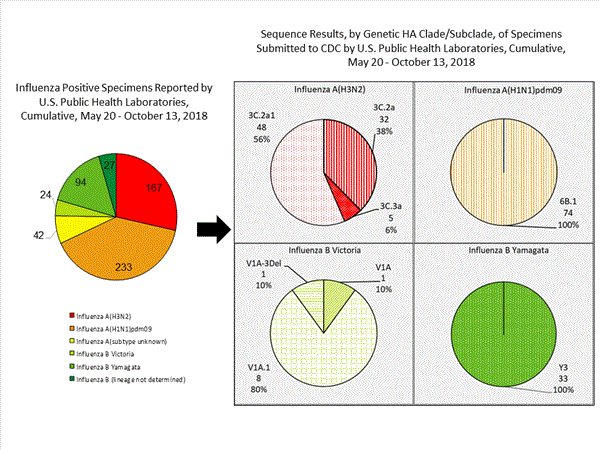
View Chart Data | View Full Screen | View PowerPoint Presentation
All data are preliminary and may change as more reports are received.
An overview of the CDC influenza surveillance system, including methodology and detailed descriptions of each data component, is available at http://www.cdc.gov/flu/weekly/overview.htm.,
Synopsis:
Influenza activity in the United States remains low. Influenza A(H1N1)pdm09, influenza A(H3N2), and influenza B viruses continue to co-circulate, with influenza A(H1N1)pdm09 viruses reported most commonly by public health laboratories during the most recent three weeks. The first influenza-associated pediatric death occurring during the 2018-2019 season was reported this week. Below is a summary of the key influenza indicators for the week ending October 13, 2018.
- Viral Surveillance: Influenza A viruses have predominated in the United States since the beginning of July. The percentage of respiratory specimens testing positive for influenza in clinical laboratories was low.
- Virus Characterization: The majority of influenza viruses characterized antigenically and genetically are similar to the cell-grown reference viruses representing the 2018?2019 Northern Hemisphere influenza vaccine viruses.
- Antiviral Resistance: All viruses tested since late May show susceptibility to the antiviral drugs oseltamivir, zanamivir, and peramivir.
- Influenza-like Illness Surveillance: The proportion of outpatient visits for influenza-like illness (ILI) remained low at 1.4%, which is below the national baseline of 2.2%. All regions reported ILI below their region-specific baseline level.
- ILI State Activity Indictor Map: New York City, the District of Columbia, and 49 states experienced minimal ILI activity, and Puerto Rico and one state had insufficient data.
- Geographic Spread of Influenza: The geographic spread of influenza in Guam and two states was reported as local activity; the District of Columbia, the U.S. Virgin Islands and 40 states reported sporadic activity; eight states reported no activity; and Puerto Rico did not report.
- Pneumonia and Influenza Mortality: The proportion of deaths attributed to pneumonia and influenza (P&I) was below the system-specific epidemic threshold in the National Center for Health Statistics (NCHS) Mortality Surveillance System.
- Influenza-associated Pediatric Deaths: One influenza-associated pediatric death that occurred during the 2018-2019 season was reported to CDC.
| Normal | 0 of 54 | 0.8% | Influenza A(H1N1)pdm09 |
| Normal | 0 of 6 | 0.6% | Influenza A |
| Normal | 0 of 4 | 0.5% | No influenza positives reported |
| Normal | 0 of 6 | 0.4% | Influenza A |
| Normal | 0 of 8 | 4.0% | Influenza A |
| Normal | 0 of 6 | 0.5% | Influenza A |
| Normal | 0 of 5 | 0.9% | Influenza A |
| Normal | 0 of 4 | 0.2% | Influenza A |
| Normal | 0 of 6 | 1.3% | Influenza A |
| Normal | 0 of 5 | 1.1% | Influenza A |
| Normal | 0 of 4 | 1.3% | Influenza A |
? Elevated means the % of visits for ILI is at or above the national or region-specific baseline
? Includes all 50 states, the District of Columbia, Guam, Puerto Rico, and U.S. Virgin Islands
? National data are for current week; regional data are for the most recent three weeks
U.S. Virologic Surveillance:
WHO and NREVSS collaborating laboratories, which include both public health and clinical laboratories located in all 50 states, Puerto Rico, Guam, and the District of Columbia, report to CDC the total number of respiratory specimens tested for influenza and the number positive for influenza by virus type. In addition, public health laboratories also report the influenza A subtype (H1 or H3) and influenza B lineage information of the viruses they test and the age or age group of the persons from whom the specimens were collected.
Additional virologic data, including national, regional and select state-level data, can be found at: http://gis.cdc.gov/grasp/fluview/flu...dashboard.html. Age group proportions and totals by influenza subtype reported by public health laboratories can be found at: http://gis.cdc.gov/grasp/fluview/flu_by_age_virus.html.
The results of tests performed by clinical laboratories are summarized below.
| 11,444 | 26,784 |
| 92 (0.8%) | 386 (1.4%) |
| 63 (68.5%) | 292 (75.6%) |
| 29 (31.5%) | 94 (24.4%) |

View National and Regional Level Graphs and Data | View Chart Data | View Full Screen | View PowerPoint Presentation
The results of tests performed by public health laboratories are summarized below.
| 369 | 880 |
| 22 | 61 |
| 19 (86.4%) | 50 (82.0%) |
| 14 (77.8%) | 32 (76.2%) |
| 4 (22.2%) | 10 (23.8%) |
| 1 | 8 |
| 3 (13.6%) | 11 (18.0%) |
| 1 (50.0%) | 8 (80.0%) |
| 1 (50.0%) | 2 (20.0%) |
| 1 | 1 |

View National and Regional Level Graphs and Data | View Chart Data | View Full Screen | View PowerPoint Presentation
Influenza Virus Characterization:
Close monitoring of influenza viruses is required to better assess the potential impact on public health. CDC characterizes influenza viruses through one or more tests including genomic sequencing, hemagglutination inhibition (HI) and/or neutralization assays based Focus Reduction assays (FRA). These data are used to compare how similar currently circulating influenza viruses are to the reference viruses used for developing new influenza vaccines and to monitor evolutionary changes that continually occur in influenza viruses circulating in humans. Antigenic and genetic characterization of circulating influenza viruses gives an indication of the influenza vaccine's ability to induce an immune response against the wide array of influenza viruses that are co-circulating every season. However, annual vaccine effectiveness estimates are needed to determine how much protection was provided to the population by vaccination.
For nearly all influenza-positive surveillance samples received at CDC, next-generation sequencing is performed to determine the genetic identity of circulating influenza viruses and to monitor the evolutionary trajectory of viruses circulating in our population. Virus gene segments are classified into genetic clades/subclades based on phylogenetic analysis. However, genetic changes that classify the clades/subclades do not always result in antigenic changes. ?Antigenic drift? is a term used to describe gradual antigenic change that occurs as viruses evolve changes to escape host immune pressure. Antigenic drift is evaluated by comparing antigenic properties of cell-propagated reference viruses representing currently recommended vaccine components with those of cell-propagated circulating viruses.
CDC has antigenically or genetically characterized 202 influenza viruses collected May 20 ? October 13, 2018 and submitted by U.S. laboratories, including 74 influenza A(H1N1)pdm09 viruses, 85 influenza A(H3N2) viruses, and 43 influenza B viruses.
Influenza A Viruses
Influenza B Viruses
The majority of U.S. viruses submitted for characterization come from state and local public health laboratories. Due to Right Size Roadmapconsiderations, specimen submission guidance to laboratories is that, if available, 2 influenza A(H1N1)pdm09, 2 influenza A(H3N2), and 2 influenza B viruses be submitted every other week. Therefore, the numbers of each virus type/subtype characterized should be more balanced across subtypes/lineages but will not reflect the actual proportion of circulating viruses. In the figure below, the results of tests performed by public health labs are shown on the left and CDC sequence results (by genetic clade/subclade) are shown on the right.

View Chart Data | View Full Screen | View PowerPoint Presentation
- A (H1N1)pdm09: Phylogenetic analysis of the HA genes from 74 A(H1N1)pdm09 viruses showed that all belonged to clade 6B.1. Fifty-seven A(H1N1)pdm09 viruses were antigenically characterized, and 57 (100%) were antigenically similar (analyzed using HI with ferret antisera) to A/Michigan/45/2015 (6B.1), a cell-propagated A/Michigan/45/2015-like reference virus representing the A(H1N1)pdm09 component for the 2018-19 Northern Hemisphere influenza vaccines.
- A (H3N2): Phylogenetic analysis of the HA genes from 85 A(H3N2) viruses revealed extensive genetic diversity with multiple clades/subclades co-circulating. The HA genes of circulating viruses belonged to clade 3C.2a (n=32), subclade 3C.2a1 (n=48) or clade 3C.3a (n=5). Forty-three influenza A(H3N2) viruses were antigenically characterized by FRA with ferret antisera, and 40 (93.0%) A(H3N2) viruses tested were well-inhibited (reacting at titers that were within fourfold of the homologous virus titer) by ferret antisera raised against A/Singapore/INFIMH-16-0019/2016 (3C.2a1), a cell-propagated A/Singapore/INFIMH-16-0019/2016 -like reference virus representing the A(H3N2) component of 2018-19 Northern Hemisphere influenza vaccines.
- B/Victoria: Phylogenetic analysis of 10 B/Victoria-lineage viruses indicate that all HA genes belonged to genetic clade V1A, however genetic subclades which are antigenically distinct have emerged. The majority of recent B/Victoria-lineage viruses belonged to a subclade of viruses with a 6-nucleotide deletion (encoding amino acids 162 and 163) in the HA (V1A.1, previously abbreviated as V1A-2Del). In addition, a small number of B/Victoria-lineage viruses have a three amino acid deletion (162-164) in the HA protein (abbreviated as V1A-3Del). Nine (90%) B/Victoria lineage viruses were well-inhibited by ferret antisera raised against cell-propagated B/Colorado/06/2017-like (V1A.1) reference virus, representing the the B/Victoria lineage component of 2018-19 Northern Hemisphere influenza vaccines. One (10%) B/Victoria lineage virus reacted poorly (at titers that were 8-fold or greater reduced compared with the homologous virus titer) with ferret antisera raised against cell-propagated B/Colorado/06/2017-like reference virus, and belonged to clade V1A.
- B/Yamagata: Phylogenetic analysis of 33 influenza B/Yamagata-lineage viruses indicate that the HA genes belonged to clade Y3. A total of 32 influenza B/Yamagata-lineage viruses were antigenically characterized, and all were antigenically similar to cell-propagated B/Phuket/3073/2013 (Y3), the reference vaccine virus representing the influenza B/Yamagata-lineage component of the 2018-19 Northern Hemisphere quadrivalent vaccines.
During May 20-October 13, 2018, 164 specimens (63 influenza A(H1N1)pdm09, 57 influenza A(H3N2), and 44 influenza B viruses) collected in the United States were tested for susceptibility to the neuraminidase inhibitors (oseltamivir, zanamivir, and peramivir). All tested viruses were sensitive to all three recommended antiviral medications.
While all of the recently circulating influenza viruses are susceptible to the neuraminidase inhibitor antiviral medications oseltamivir, zanamivir, and peramivir; rare sporadic instances of oseltamivir-resistant and peramivir-resistant influenza A(H1N1)pdm09 viruses and oseltamivir-resistant influenza A(H3N2) viruses have been detected worldwide. Antiviral treatment as early as possible is recommended for patients with confirmed or suspected influenza who have severe, complicated, or progressive illness; who require hospitalization; or who are at high risk for serious influenza-related complications. Additional information on recommendations for treatment and chemoprophylaxis of influenza virus infection with antiviral agents is available at http://www.cdc.gov/flu/antivirals/index.htm.
Outpatient Illness Surveillance:
Nationwide during week 41, 1.4% of patient visits reported through the U.S. Outpatient Influenza-like Illness Surveillance Network (ILINet) were due to influenza-like illness (ILI). This percentage is below the national baseline of 2.2%. (ILI is defined as fever (temperature of 100?F [37.8?C] or greater) and cough and/or sore throat.)
On a regional level, the percentage of outpatient visits for ILI ranged from 0.7% to 2.0% during week 41. All regions reported a percentage of outpatient visits for ILI below their region-specific baseline.
Additional data on medically attended visits for ILI for current and past seasons and by geography (national, HHS region, or select states) are available on FluView Interactive http://gis.cdc.gov/grasp/fluview/flu...dashboard.html.
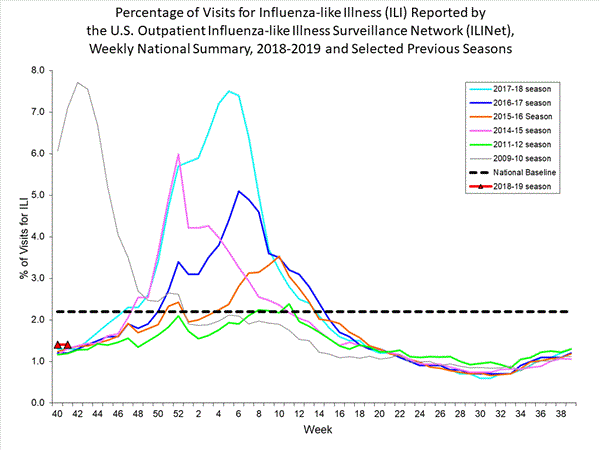
View National and Regional Level Graphs and Data | View Chart Data | View Full Screen | View PowerPoint Presentation
ILINet State Activity Indicator Map:
Data collected in ILINet are used to produce a measure of ILI activity* by state. Activity levels are based on the percent of outpatient visits in a state due to ILI and are compared to the average percent of ILI visits that occur during weeks with little or no influenza virus circulation. Activity levels range from minimal, which would correspond to ILI activity from outpatient clinics being below, or only slightly above, the average, to high, which would correspond to ILI activity from outpatient clinics being much higher than average.
The ILI Activity Indicator Map displays state-specific activity levels for multiple seasons and allows a visual representation of relative activity from state to state. More information is available on FluView Interactive at https://gis.cdc.gov/grasp/fluview/main.html.
During week 41, the following ILI activity levels were experienced:
*This map uses the proportion of outpatient visits to health care providers for ILI to measure the ILI activity level within a state. It does not, however, measure the extent of geographic spread of flu within a state. Therefore, outbreaks occurring in a single city could cause the state to display high activity levels.
Data collected in ILINet may disproportionally represent certain populations within a state, and therefore, may not accurately depict the full picture of influenza activity for the whole state.
Data displayed in this map are based on data collected in ILINet, whereas the State and Territorial flu activity map is based on reports from state and territorial epidemiologists. The data presented in this map are preliminary and may change as more data are received.
Differences in the data presented here by CDC and independently by some state health departments likely represent differing levels of data completeness with data presented by the state likely being the more complete.
Geographic Spread of Influenza as Assessed by State and Territorial Epidemiologists
The influenza activity reported by state and territorial epidemiologists indicates geographic spread of influenza viruses, but does not measure the severity of influenza activity. Additional data displaying the influenza activity reported by state and territorial epidemiologists for the current and past seasons are available on FluView Interactive at https://gis.cdc.gov/grasp/fluview/FluView8.html
During week 41, the following influenza activity was reported::
Influenza-Associated Hospitalizations:
The Influenza Hospitalization Surveillance Network (FluSurv-NET) conducts all age population-based surveillance for laboratory-confirmed influenza-related hospitalizations in select counties in the Emerging Infections Program (EIP) states and Influenza Hospitalization Surveillance Project (IHSP) states. FluSurv-NET estimated hospitalization rates will be updated weekly starting later this season. Additional FluSurv-NET data can be found at: http://gis.cdc.gov/GRASP/Fluview/FluHospRates.html and http://gis.cdc.gov/grasp/fluview/FluHospChars.html.
Pneumonia and Influenza (P&I) Mortality Surveillance:
Based on National Center for Health Statistics (NCHS) mortality surveillance data available on October 18, 2018, 5.6% of the deaths occurring during the week ending October 6, 2018 (week 40) were due to P&I. This percentage is below the epidemic threshold of 5.8% for week 40.
Additional pneumonia and influenza mortality data for current and past seasons and by geography (national, HHS region, or state) are available at on FluView Interactive http://gis.cdc.gov/grasp/fluview/mortality.html. Data displayed on the regional and state-level are aggregated by the state of residence of the decedent.
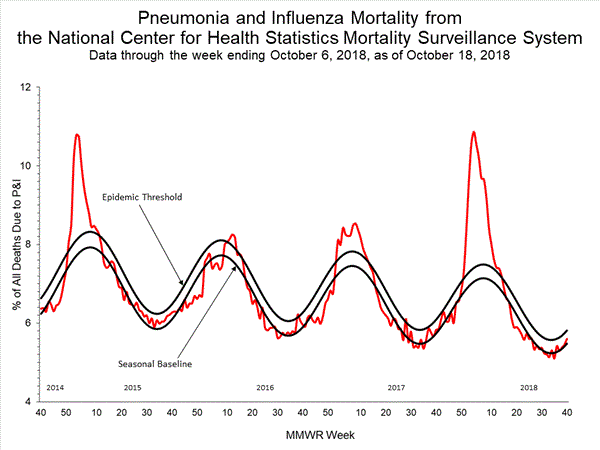
View Regional and State Level Data | View Chart Data | View Full Screen | View PowerPoint Presentation
Influenza-Associated Pediatric Mortality:
The first influenza-associated pediatric death of the 2018-2019 season was reported to CDC during week 41 (the week ending October 13, 2018). This death was associated with an influenza A virus for which no subtyping was performed.
Additional information on influenza-associated pediatric deaths including basic demographics, underlying conditions, bacterial co-infections, and place of death for the current and past seasons, is available on FluView Interactive http://gis.cdc.gov/GRASP/Fluview/PedFluDeath.html.
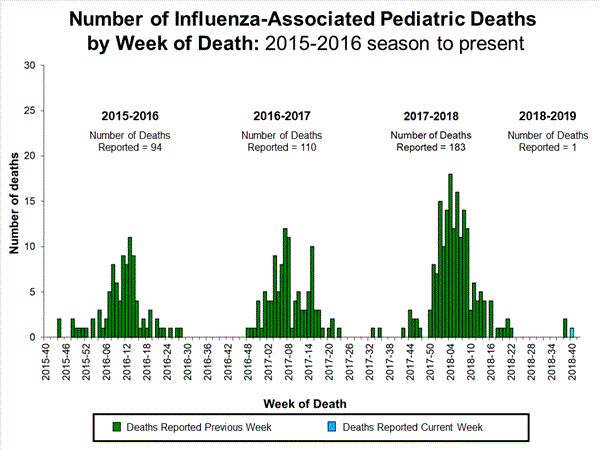
View Interactive Application | View Full Screen | View PowerPoint Presentation
Additional National and International Influenza Surveillance Information
FluView Interactive: FluView includes enhanced web-based interactive applications that can provide dynamic visuals of the influenza data collected and analyzed by CDC. These FluView Interactive applications allow people to create customized, visual interpretations of influenza data, as well as make comparisons across flu seasons, regions, age groups and a variety of other demographics. To access these tools, visithttp://www.cdc.gov/flu/weekly/fluviewinteractive.htm.
U.S. State and local influenza surveillance: Click on a jurisdiction below to access the latest local influenza information.
World Health Organization: Additional influenza surveillance information from participating WHO member nations is available through FluNetand the Global Epidemiology Reports.
WHO Collaborating Centers for Influenza located in Australia, China, Japan, the United Kingdom, and the United States (CDC in Atlanta, Georgia).
Europe: For the most recent influenza surveillance information from Europe, please see WHO/Europe and the European Centre for Disease Prevention and Control at http://www.flunewseurope.org/.
Public Health Agency of Canada: The most up-to-date influenza information from Canada is available at http://www.phac-aspc.gc.ca/fluwatch/
Public Health England: The most up-to-date influenza information from the United Kingdom is available athttps://www.gov.uk/government/statistics/weekly-national-flu-reports- New York City, the District of Columbia, Puerto Rico and 49 states experienced minimal ILI activity (Alabama, Alaska, Arizona, Arkansas, California, Colorado, Connecticut, Delaware, Florida, Georgia, Hawaii, Idaho, Illinois, Indiana, Iowa, Kansas, Kentucky, Louisiana, Maine, Maryland, Massachusetts, Michigan, Minnesota, Mississippi, Missouri, Montana, Nebraska, Nevada, New Hampshire, New Jersey, New Mexico, North Carolina, North Dakota, Ohio, Oklahoma, Oregon, Pennsylvania, Rhode Island, South Carolina, South Dakota, Tennessee, Texas, Utah, Vermont, Virginia, Washington, West Virginia, Wisconsin, and Wyoming).
- Data were insufficient to calculate an ILI activity level from one state (New York).
- Local influenza activity was reported by Guam and two states (Massachusetts and North Dakota).
- Sporadic influenza activity was reported by the District of Columbia, the U.S. Virgin Islands and 40 states (Alabama, Alaska, Arizona, Arkansas, California, Connecticut, Delaware, Florida, Georgia, Hawaii, Idaho, Indiana, Iowa, Kansas, Kentucky, Louisiana, Maine, Maryland, Michigan, Minnesota, Missouri, Montana, Nevada, New Hampshire, New Jersey, New Mexico, New York, Ohio, Oklahoma, Oregon, Pennsylvania, South Carolina, South Dakota, Texas, Utah, Vermont, Washington, West Virginia, Wisconsin and Wyoming).
- No influenza activity was reported by eight states (Colorado, Illinois, Mississippi, Nebraska, North Carolina, Rhode Island, Tennessee, and Virginia).
- Puerto Rico did not report.
- Any links provided to non-Federal organizations are provided solely as a service to our users. These links do not constitute an endorsement of these organizations or their programs by CDC or the Federal Government, and none should be inferred. CDC is not responsible for the content of the individual organization web pages found at these links.
An overview of the CDC influenza surveillance system, including methodology and detailed descriptions of each data component, is available at: http://www.cdc.gov/flu/weekly/overview.htm.
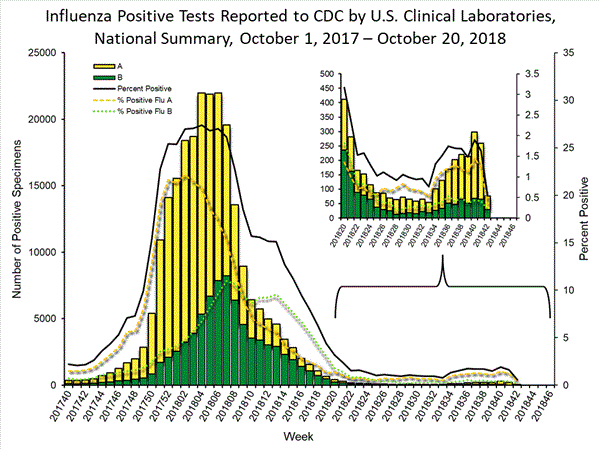
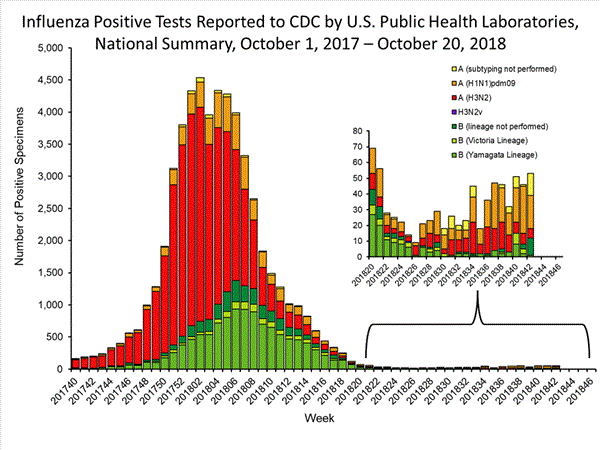
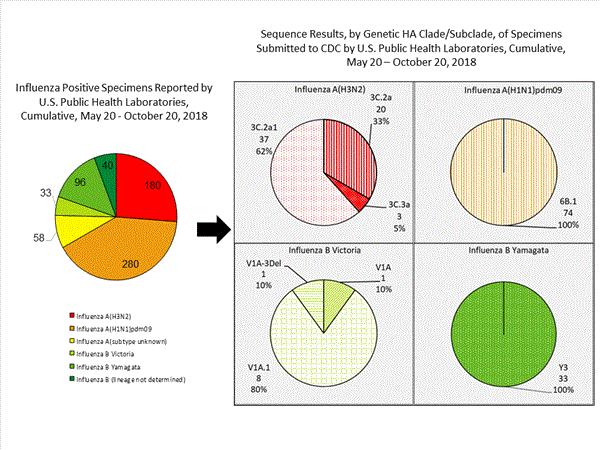
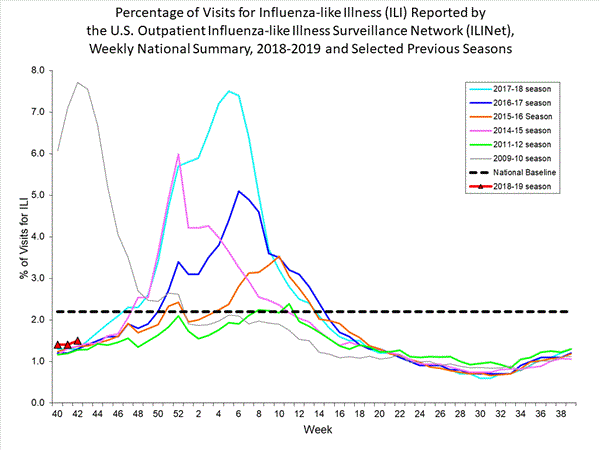
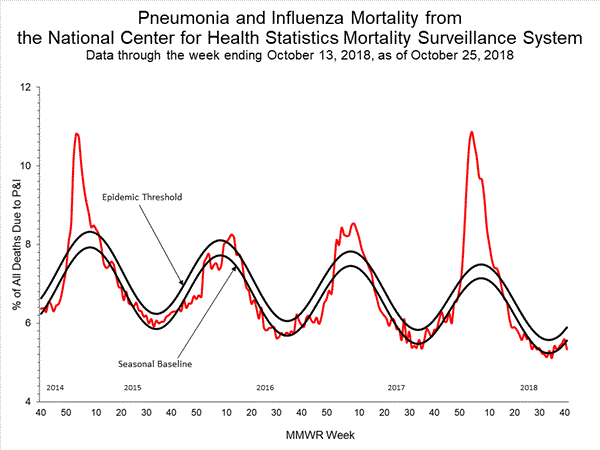
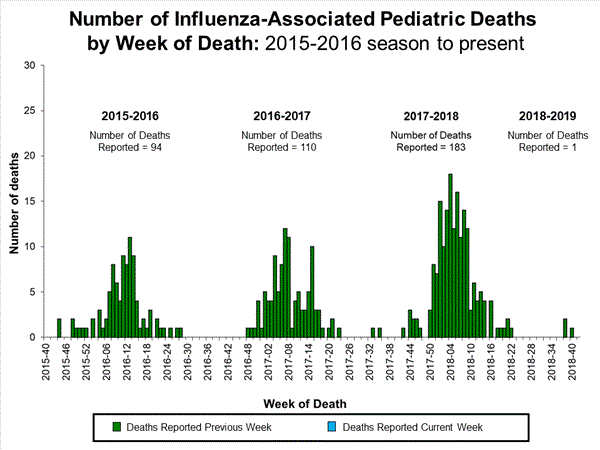
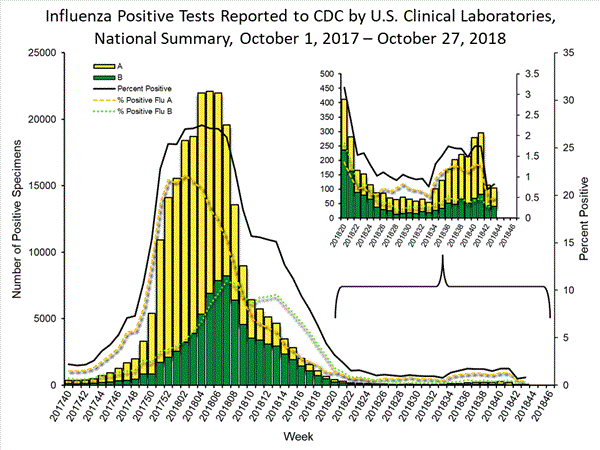
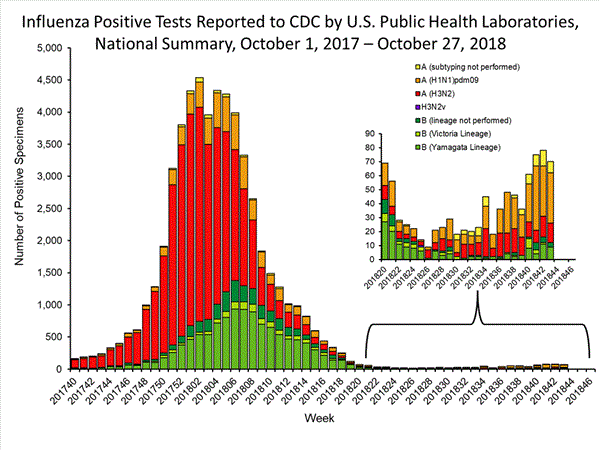
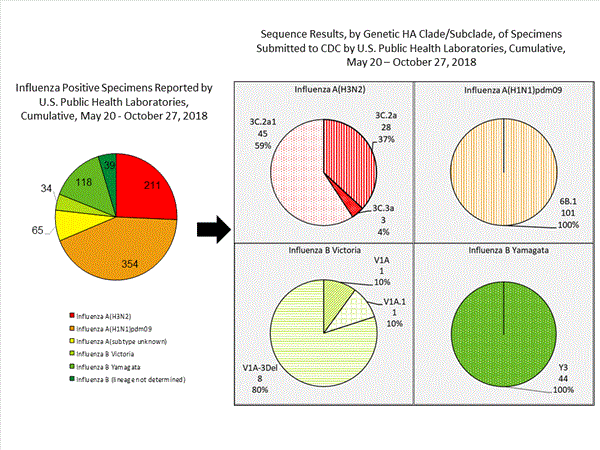
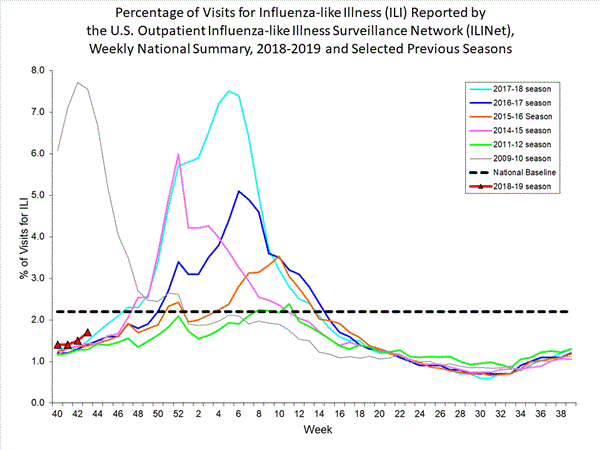
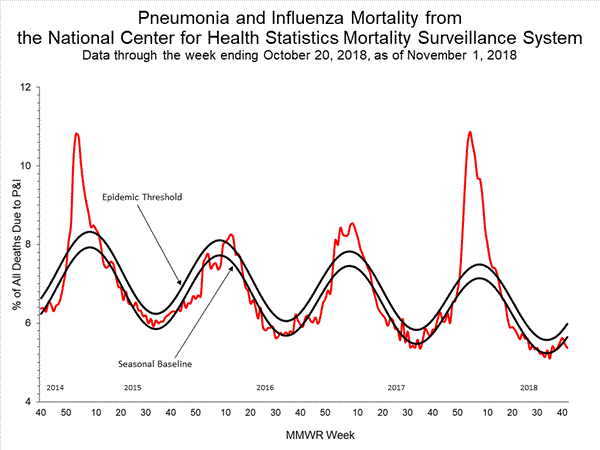
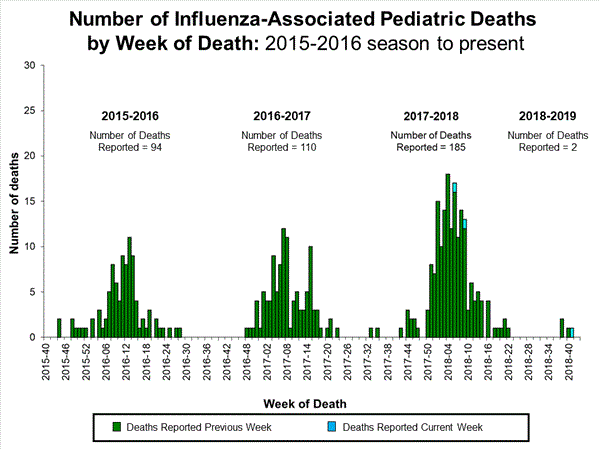


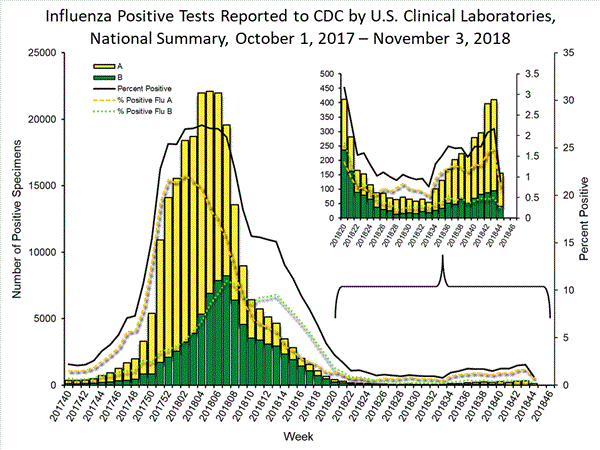
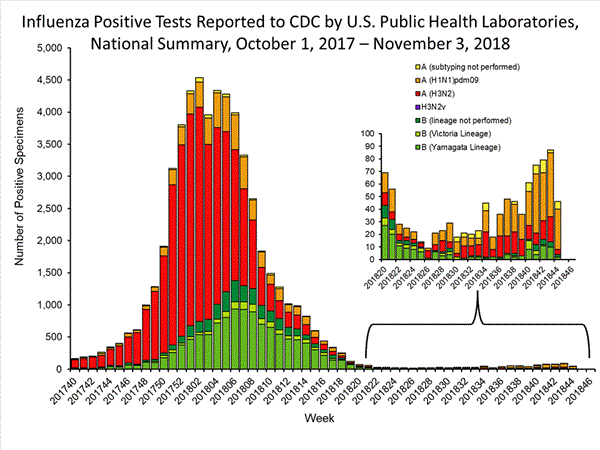
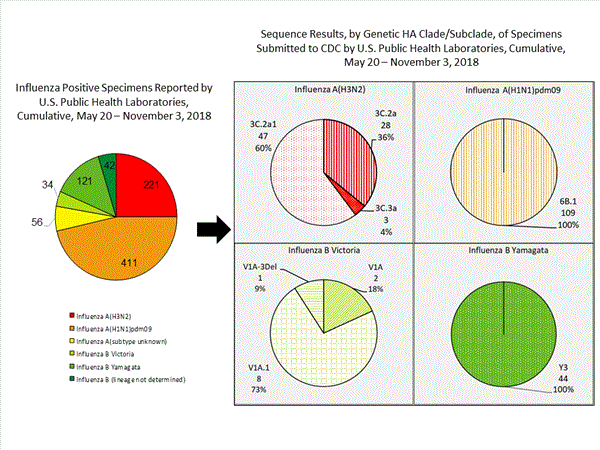
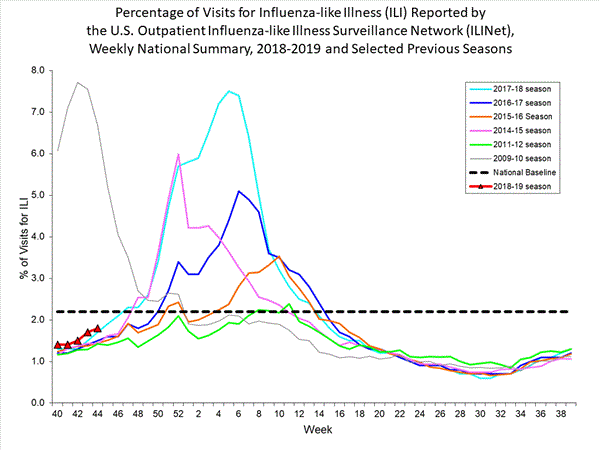
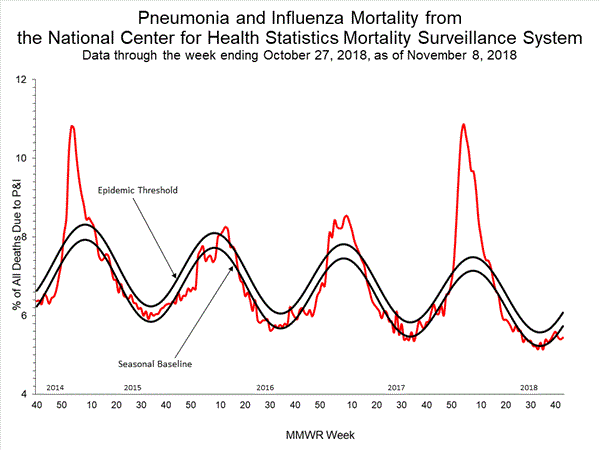
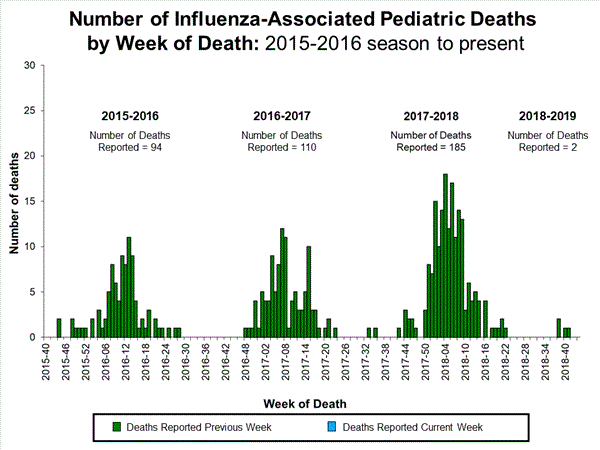
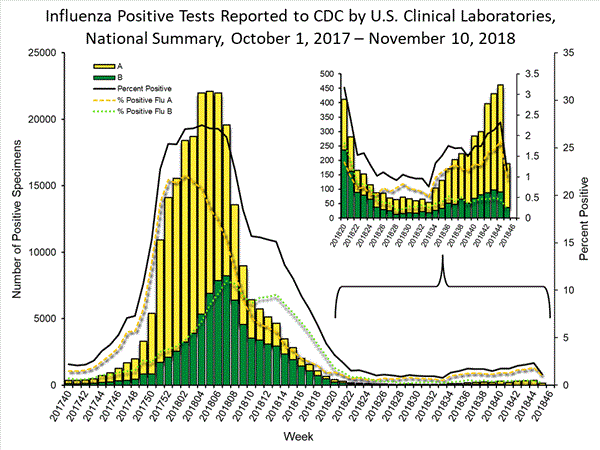
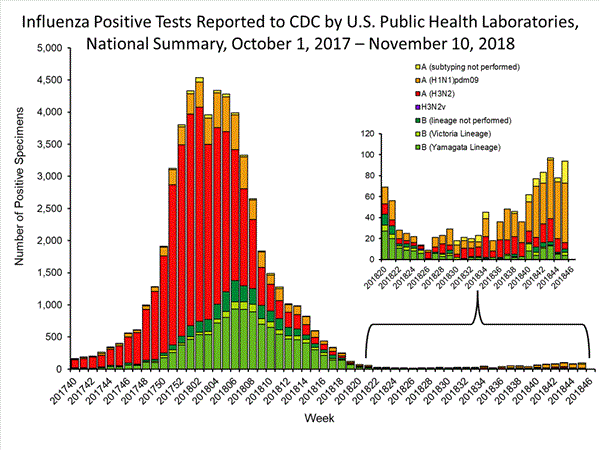
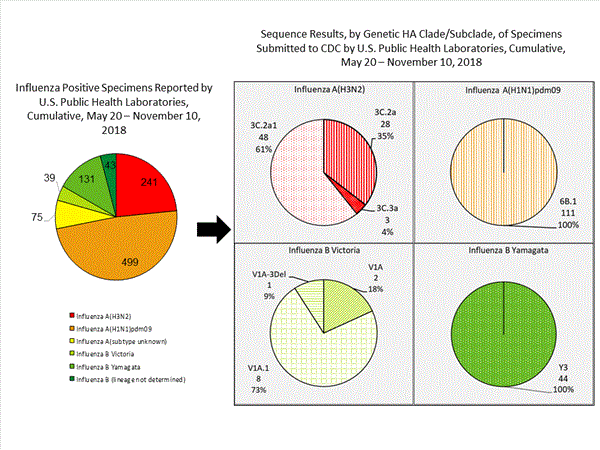
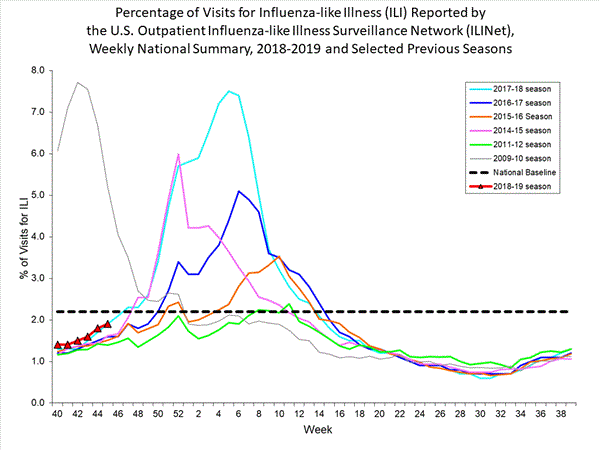
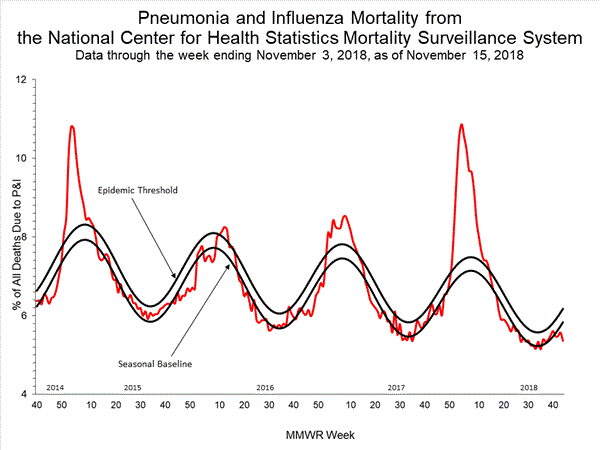
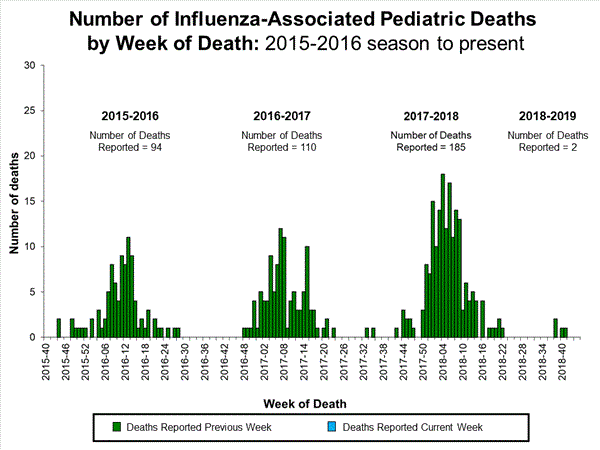
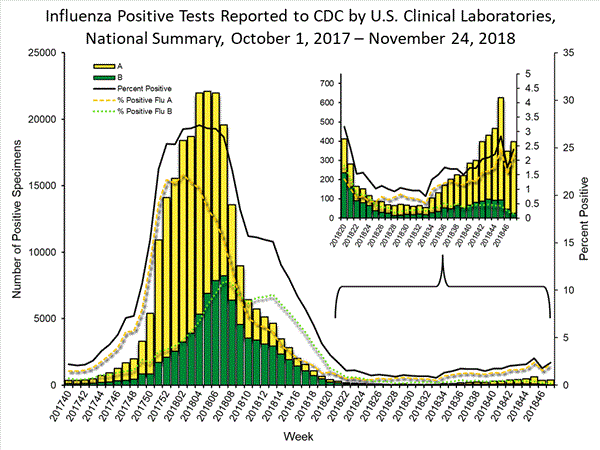
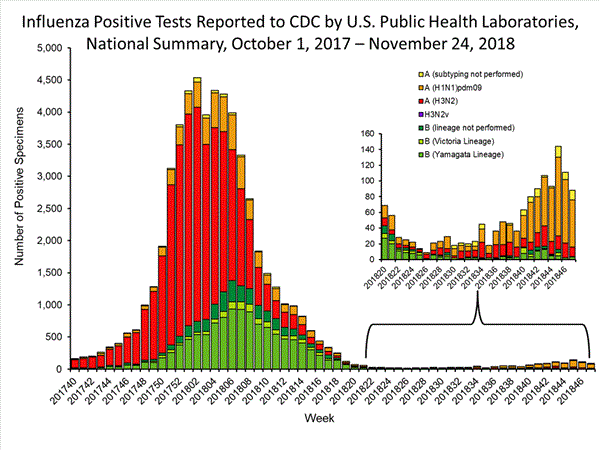
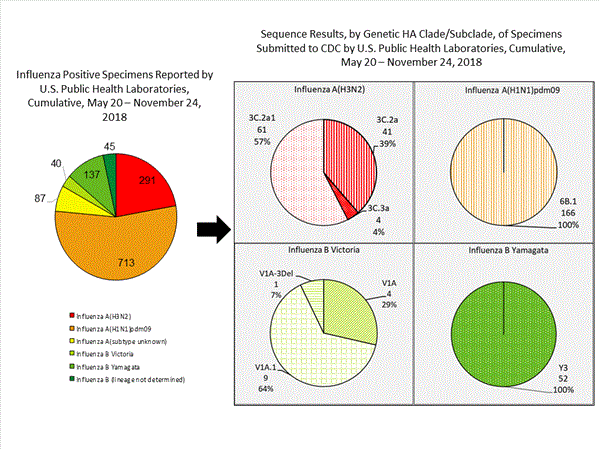
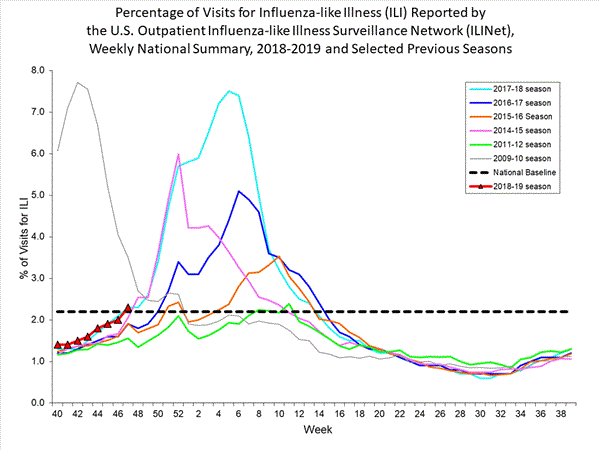
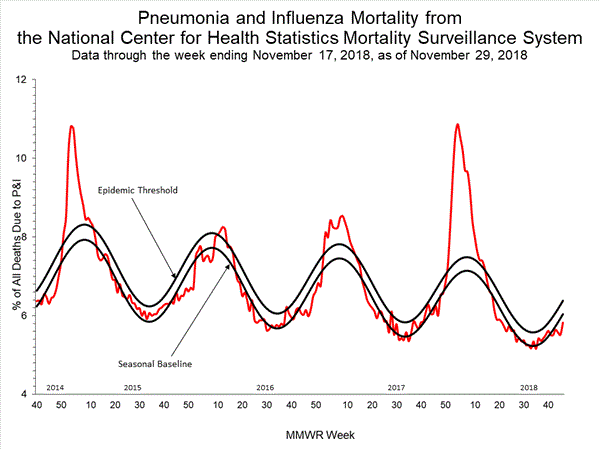
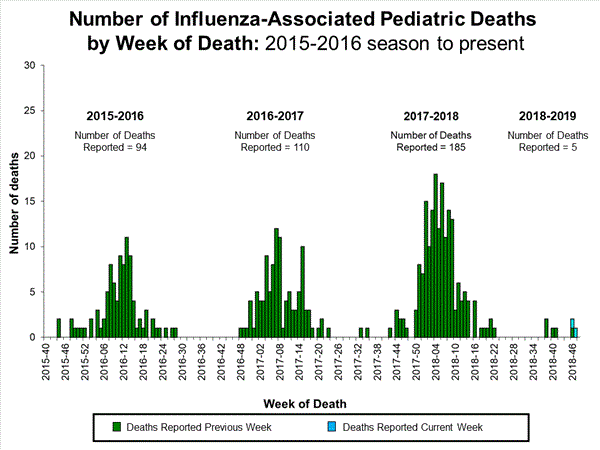
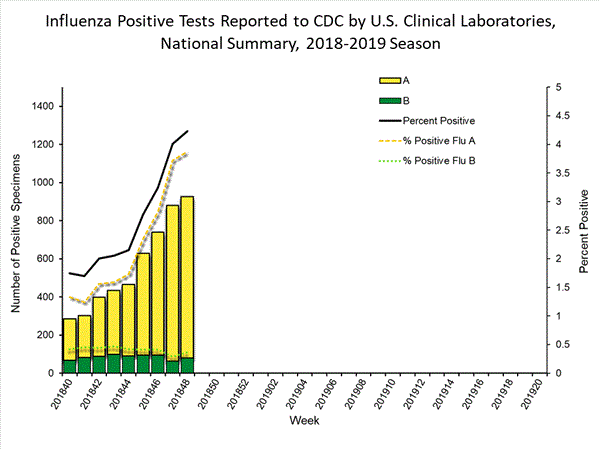
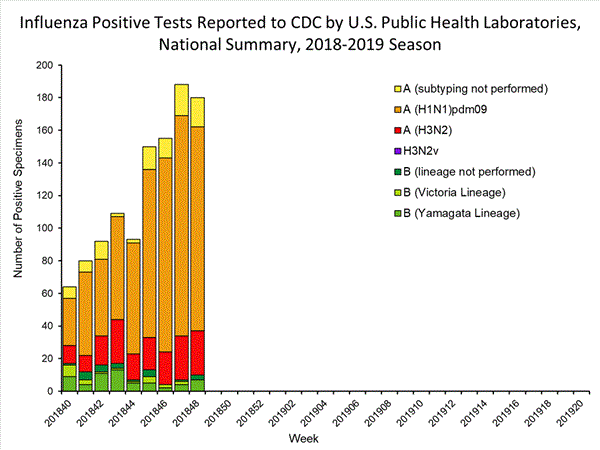
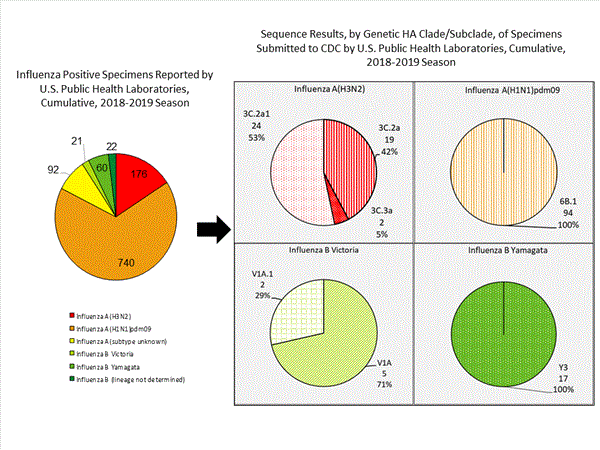
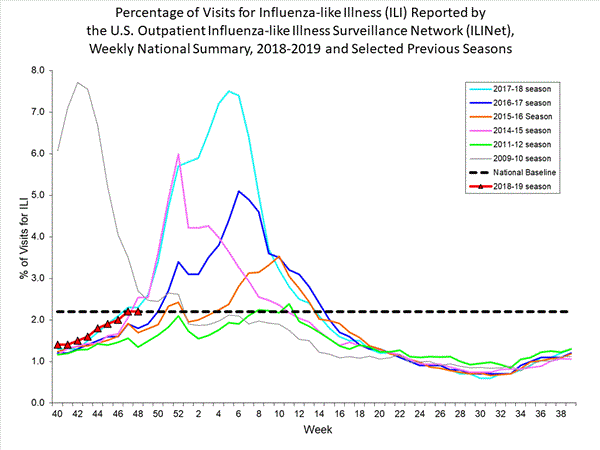
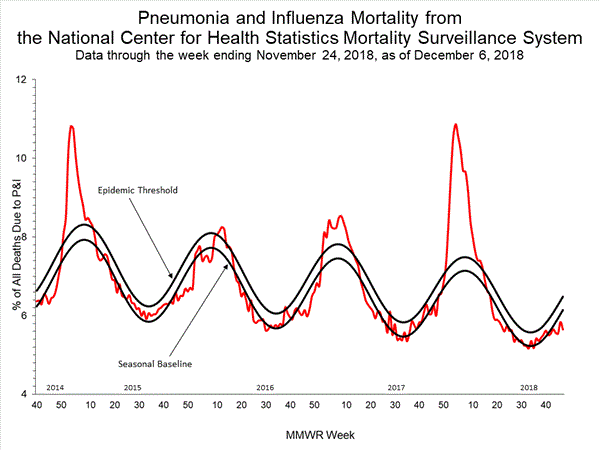
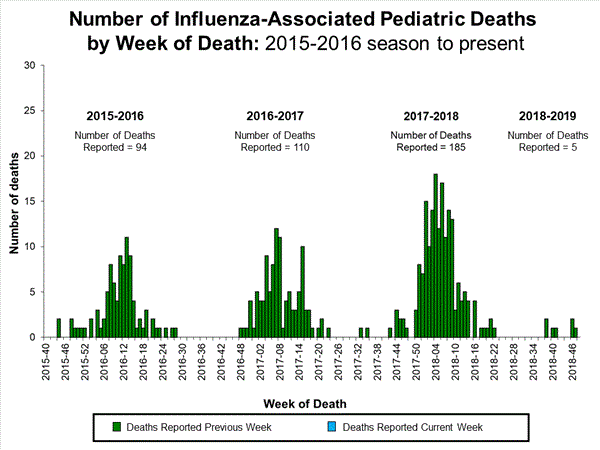
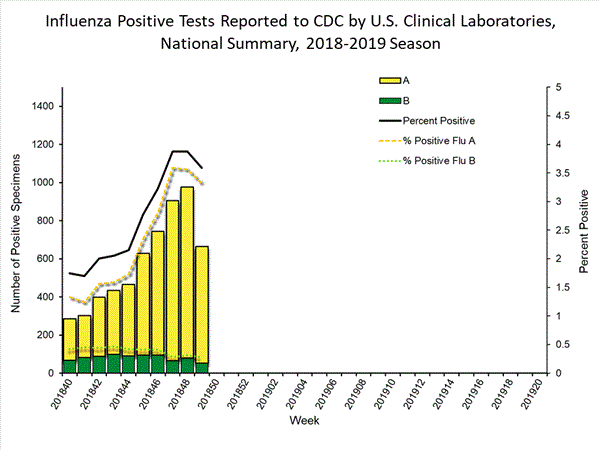
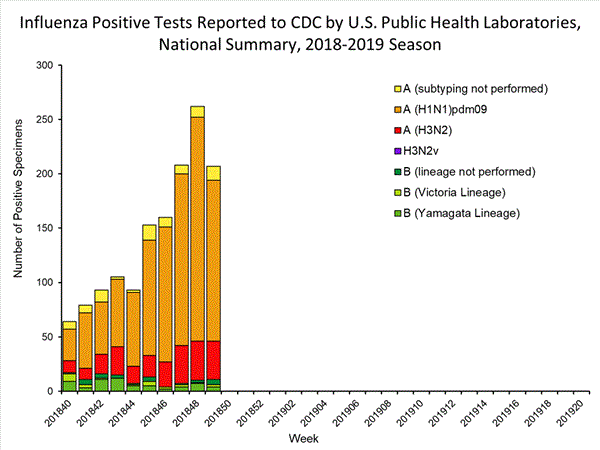
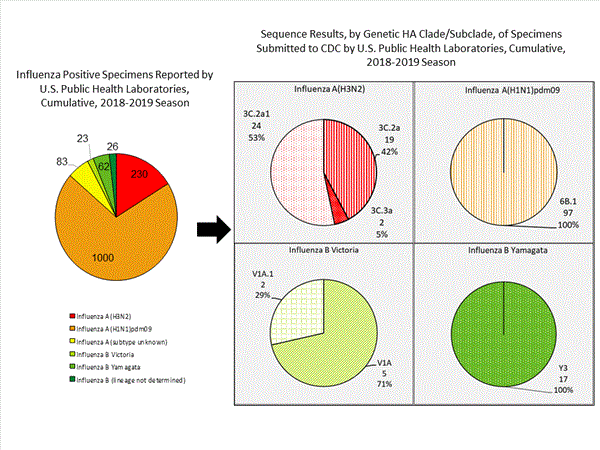
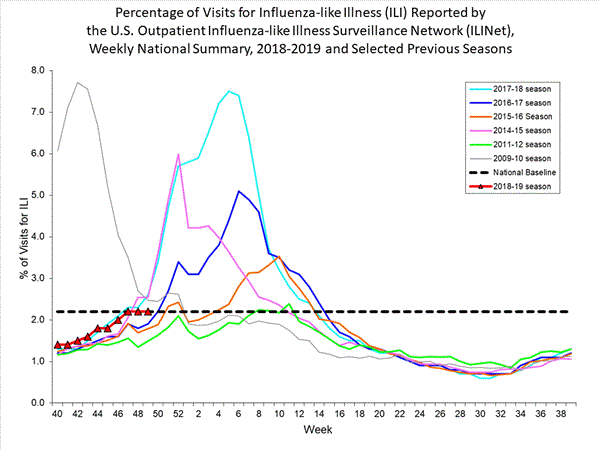
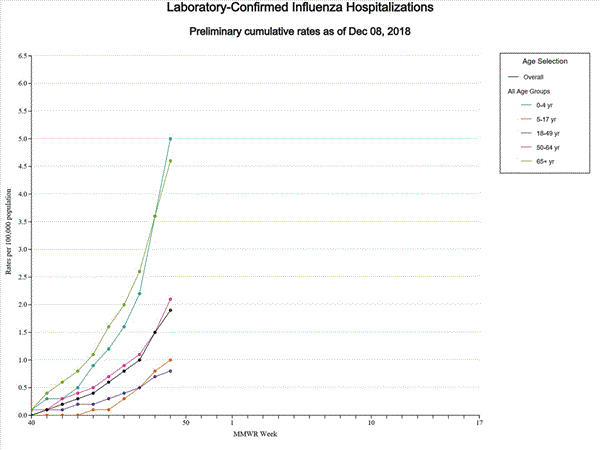
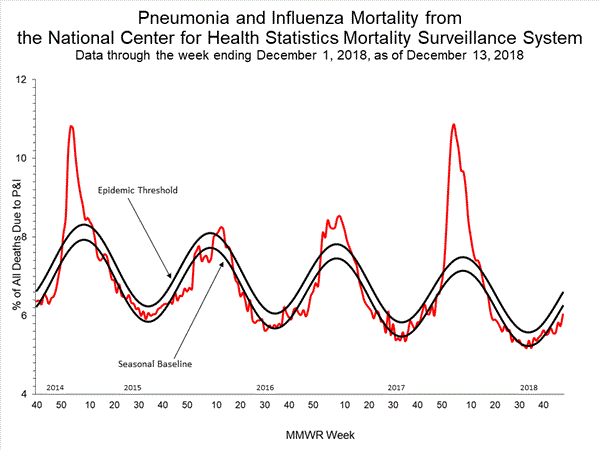
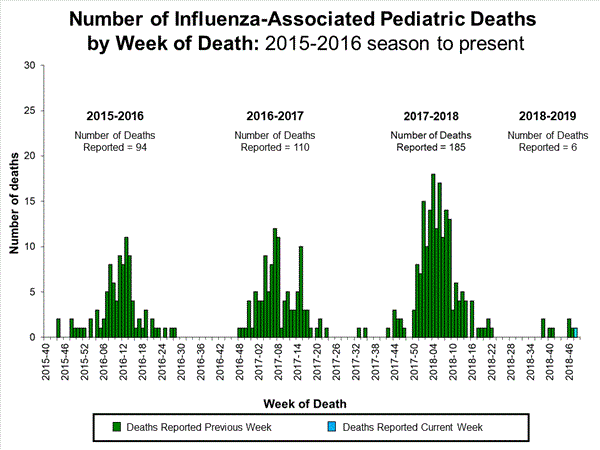
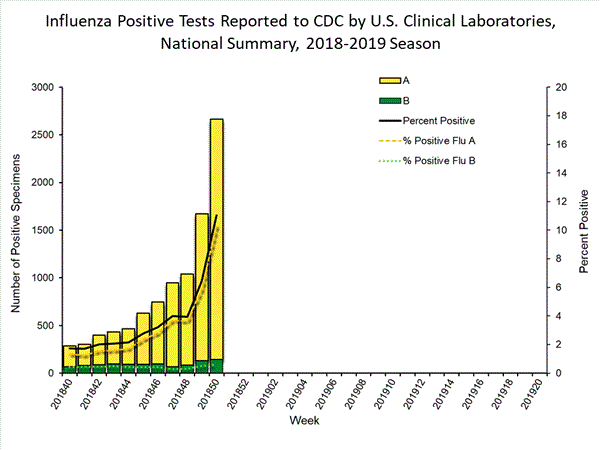
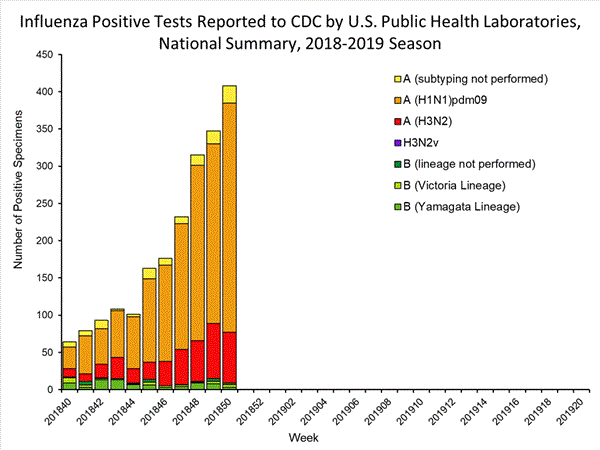
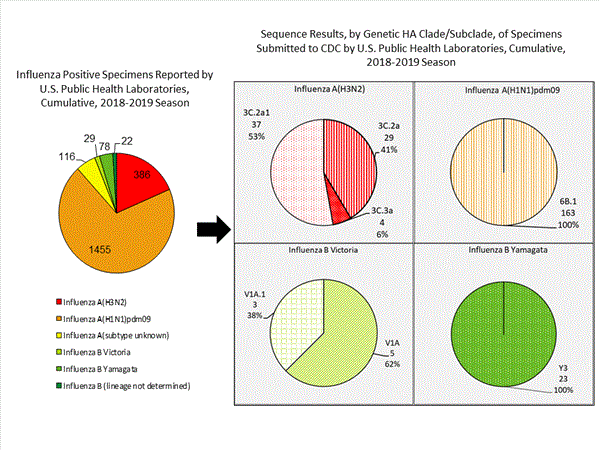
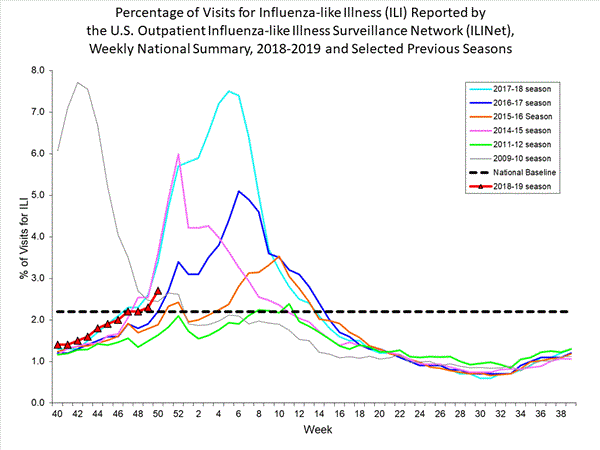
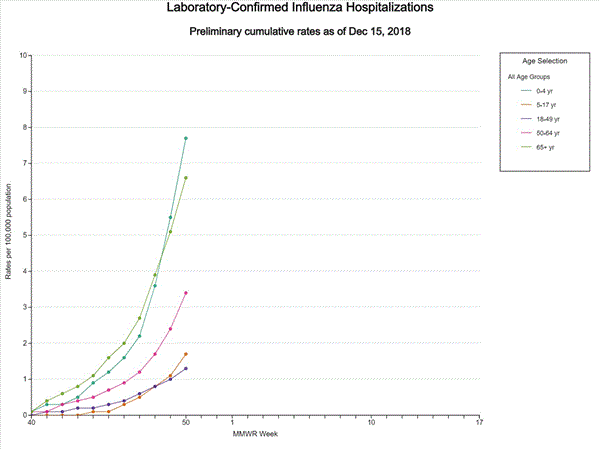
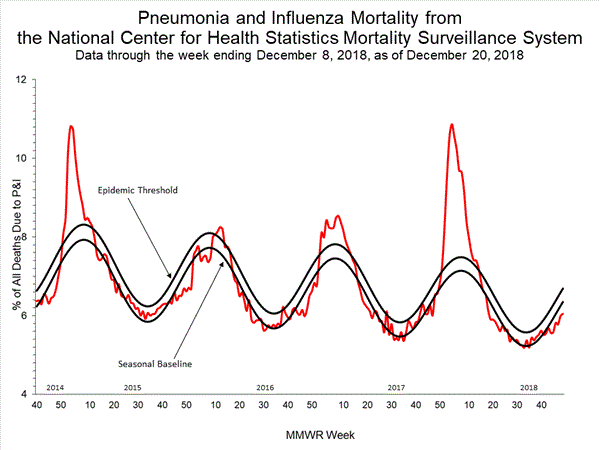
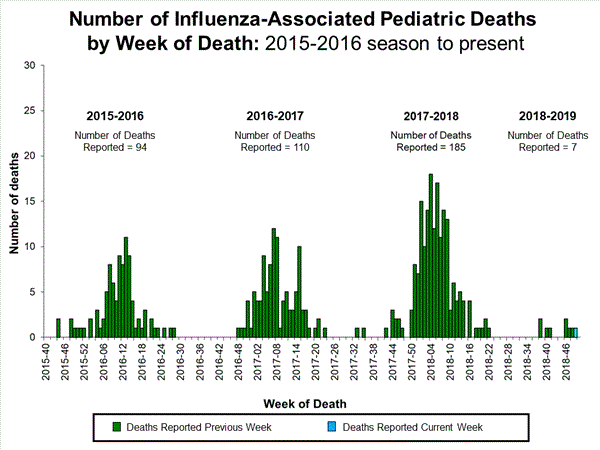
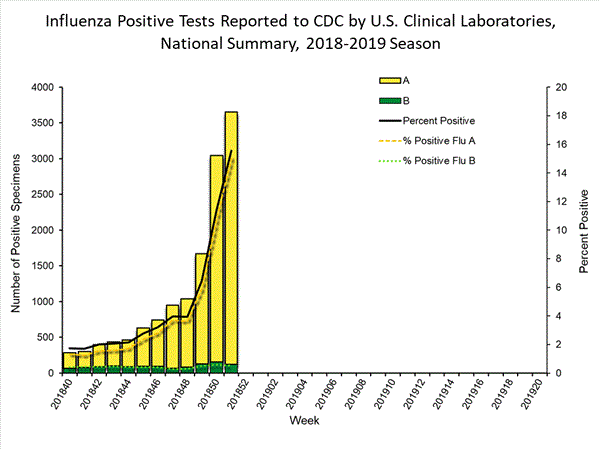
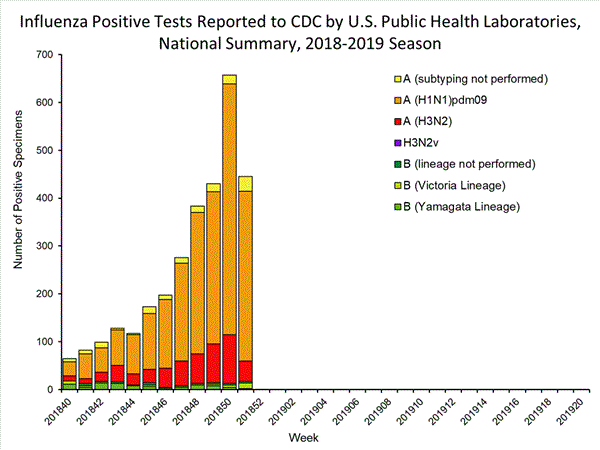
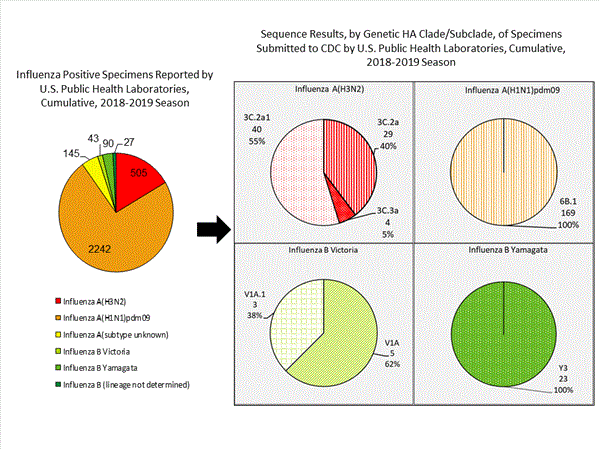
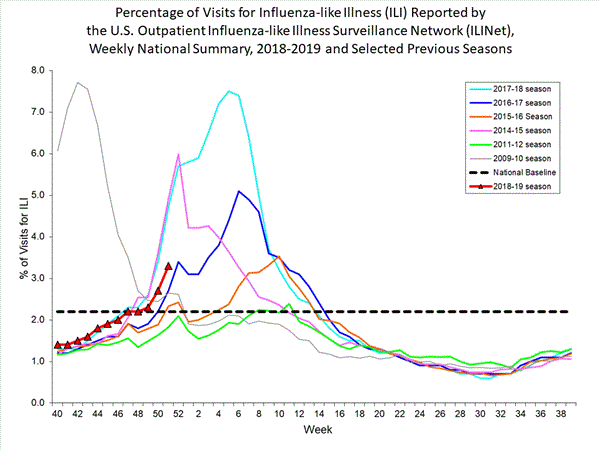
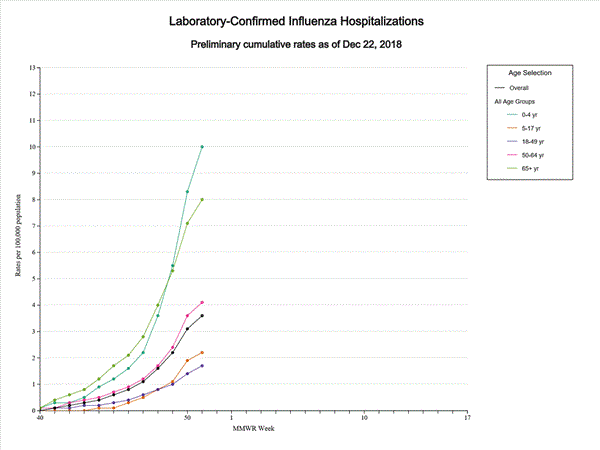
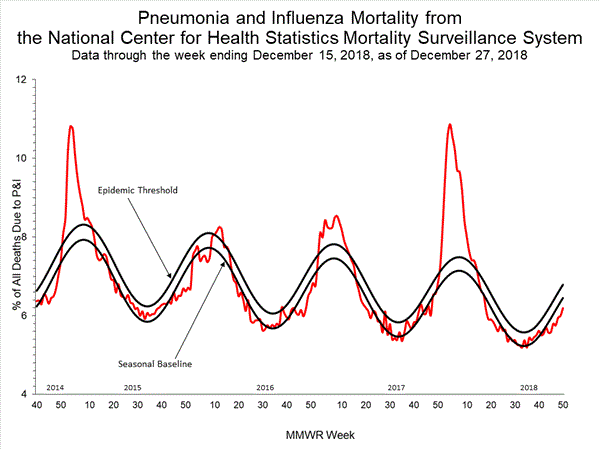
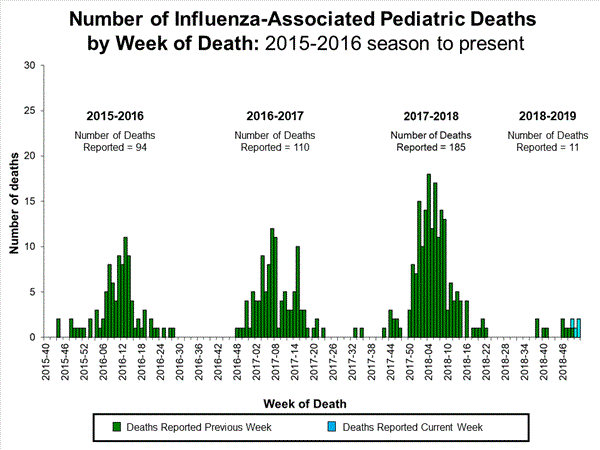

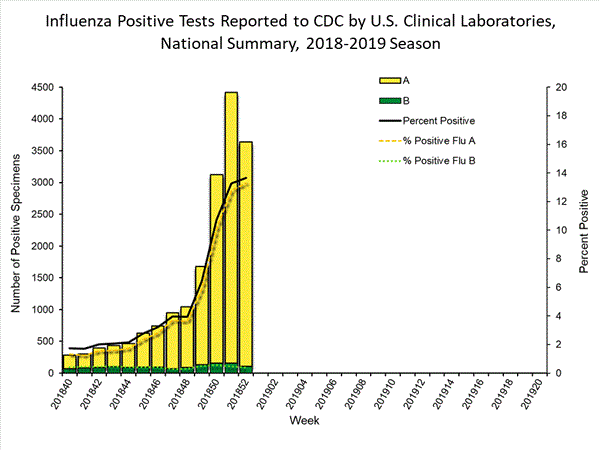
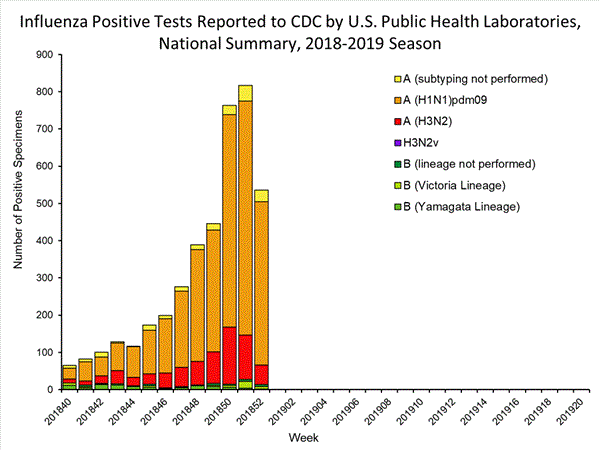
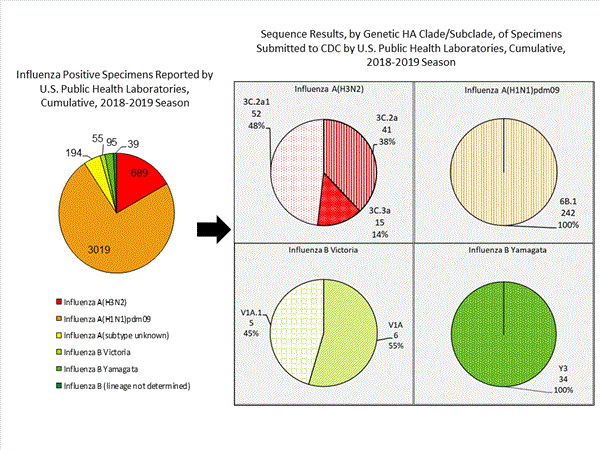
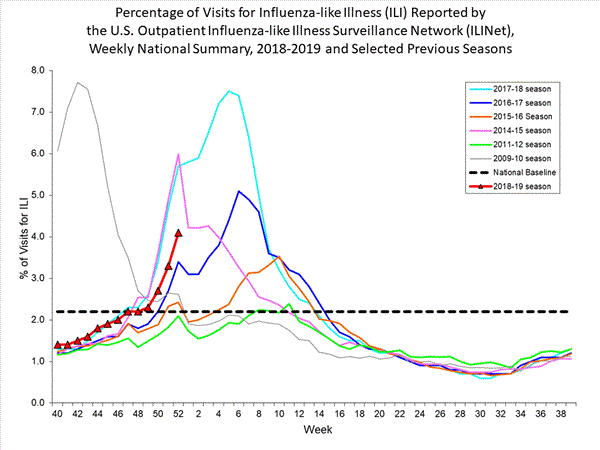
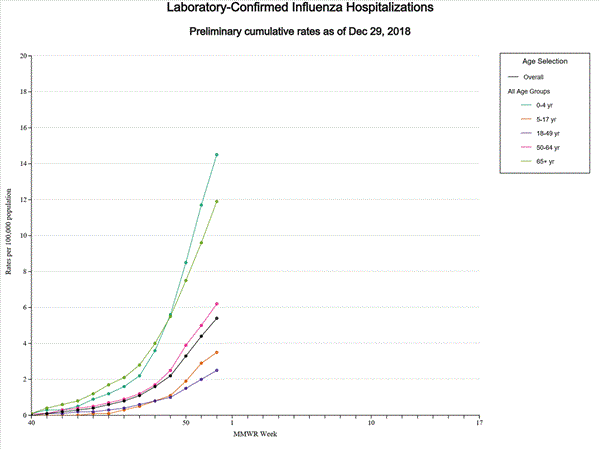
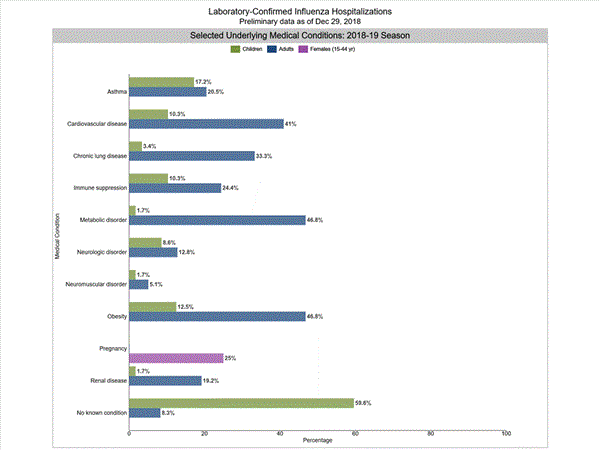
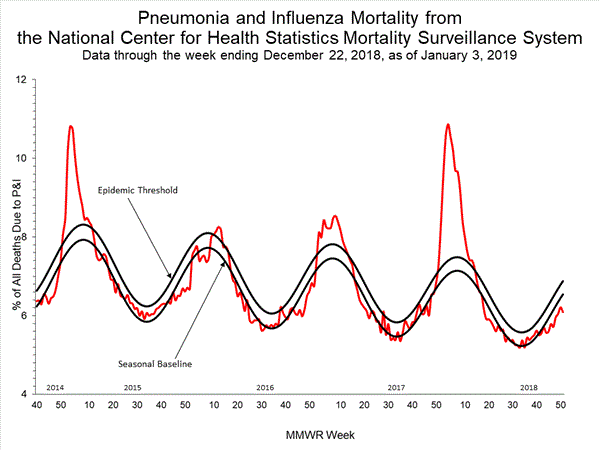
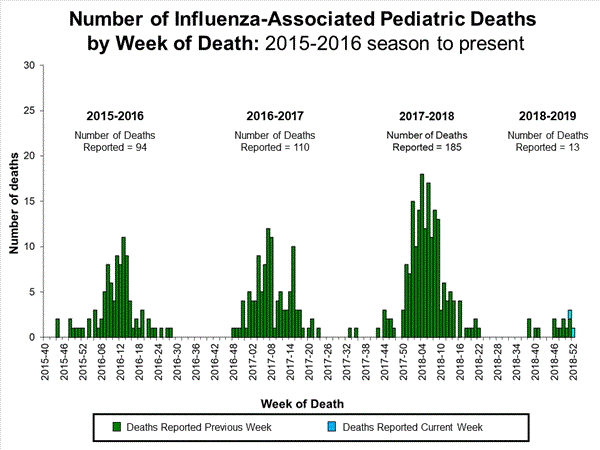
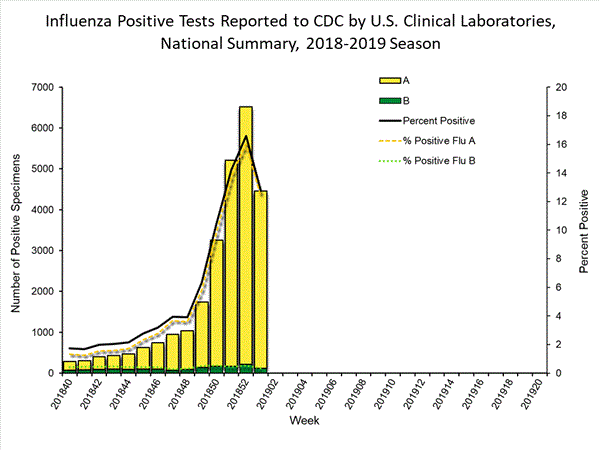
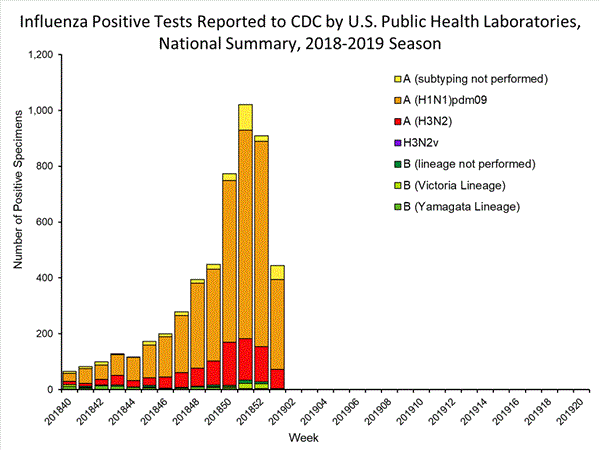
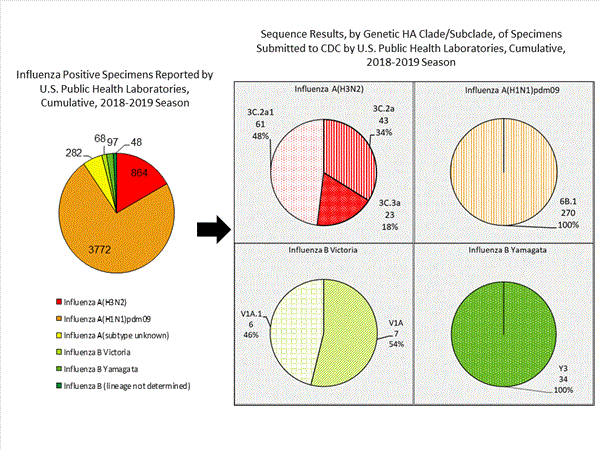
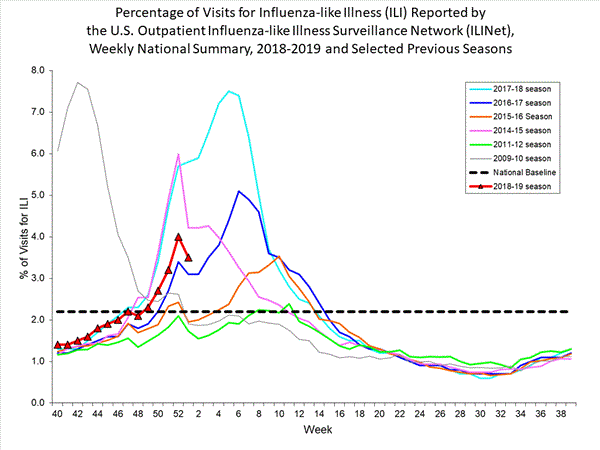
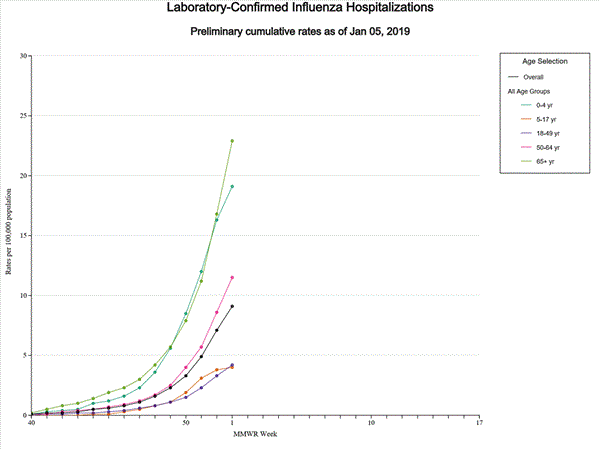
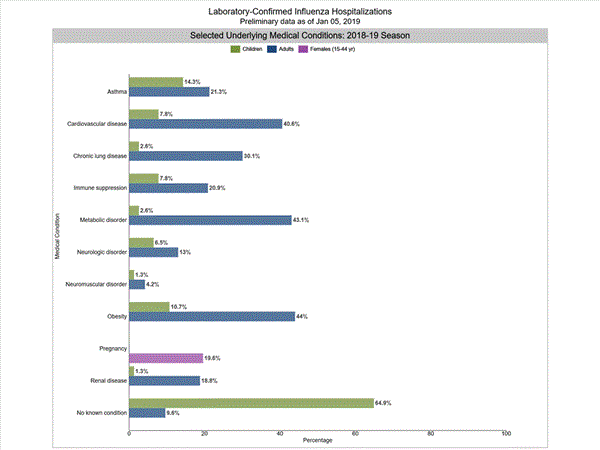
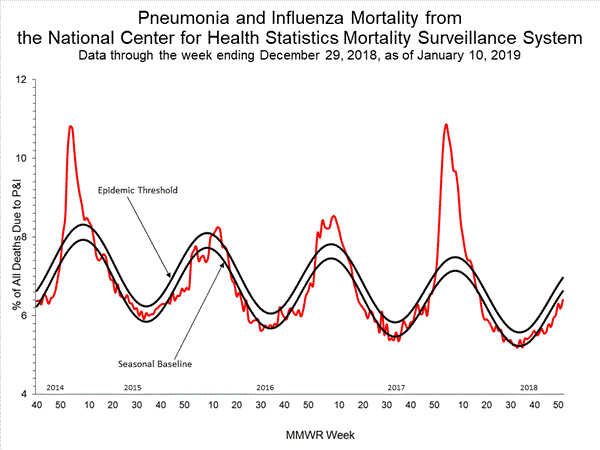
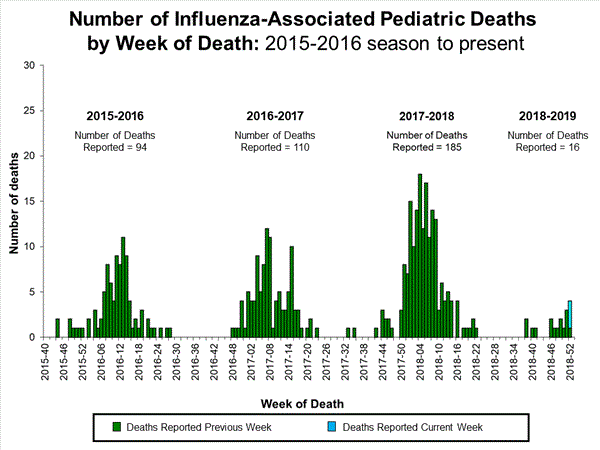
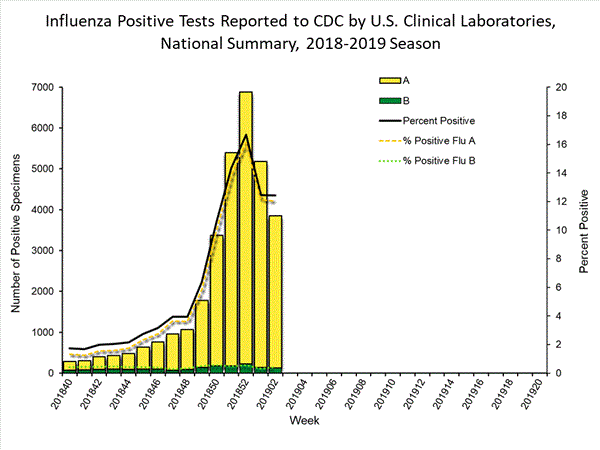
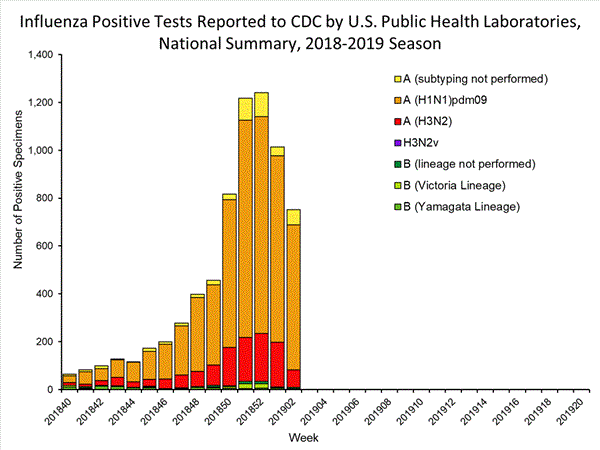
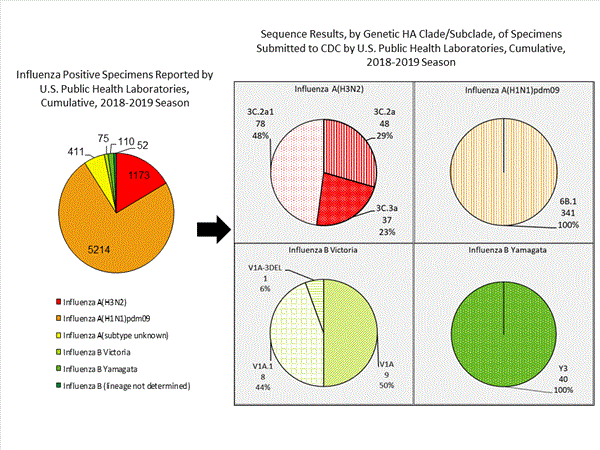
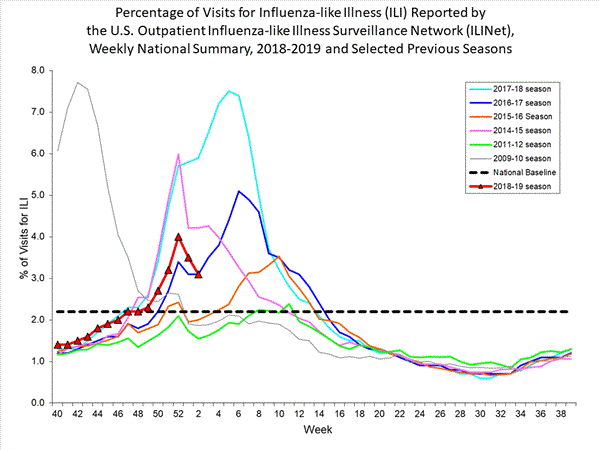
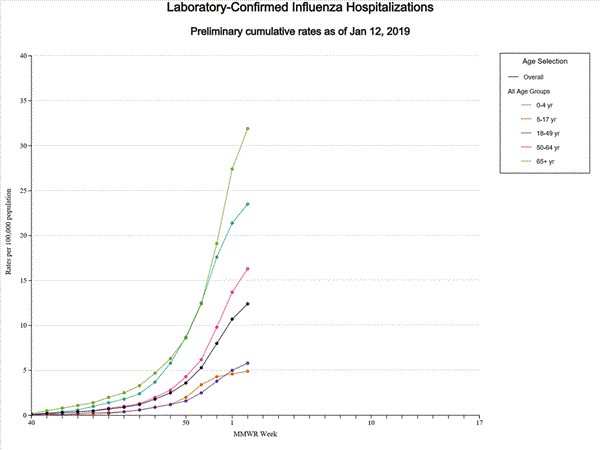
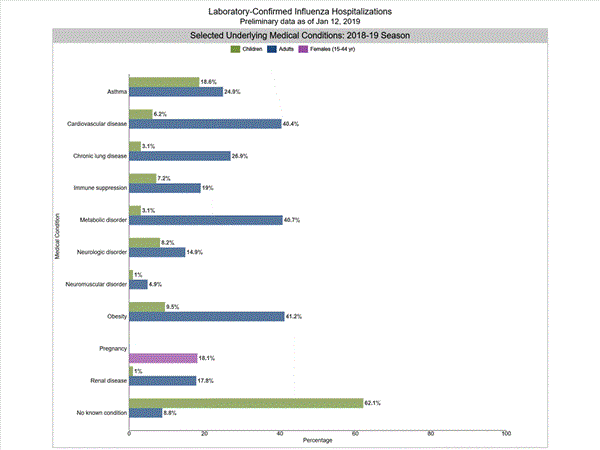
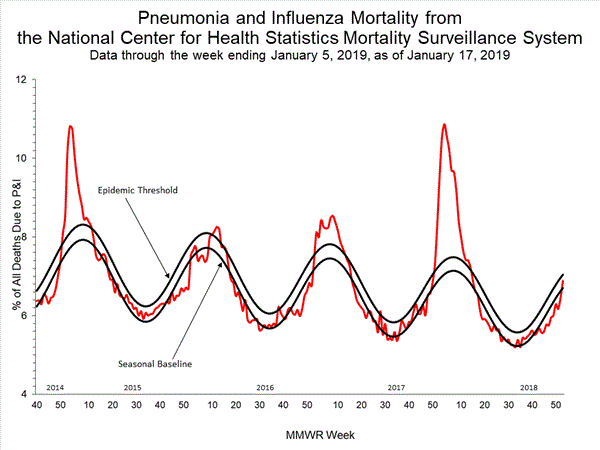
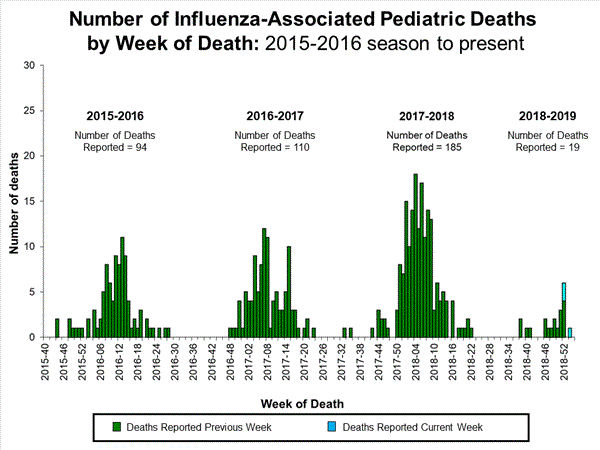
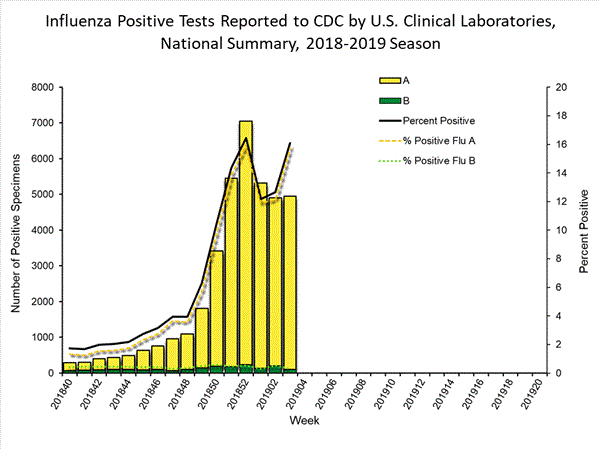
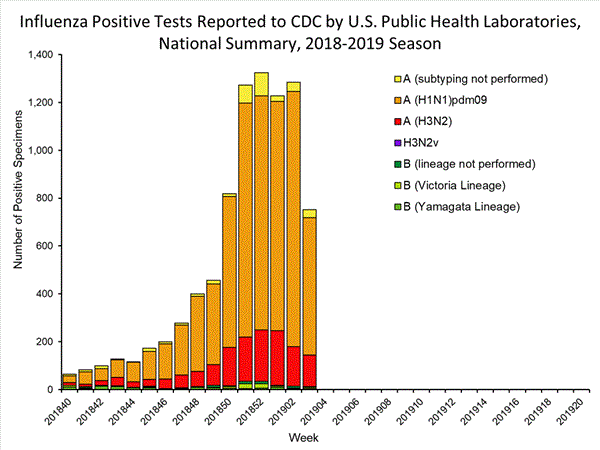
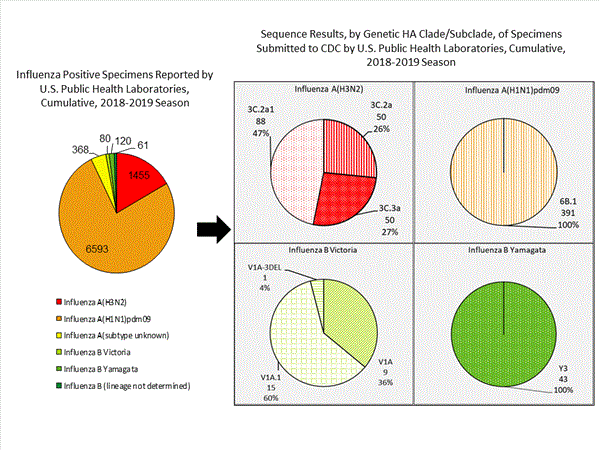
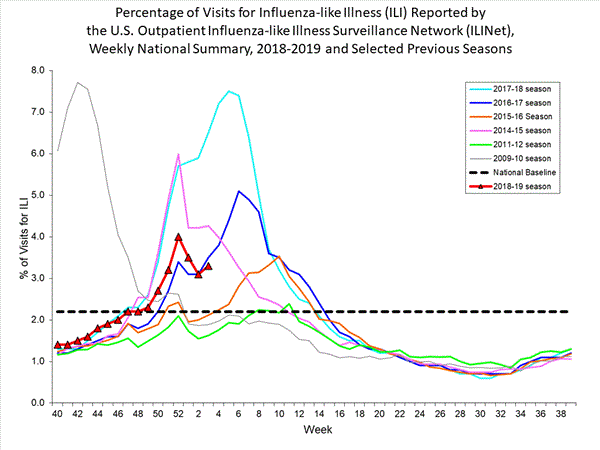
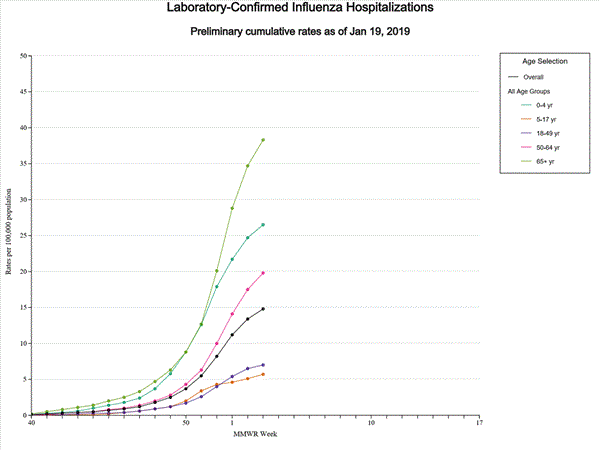
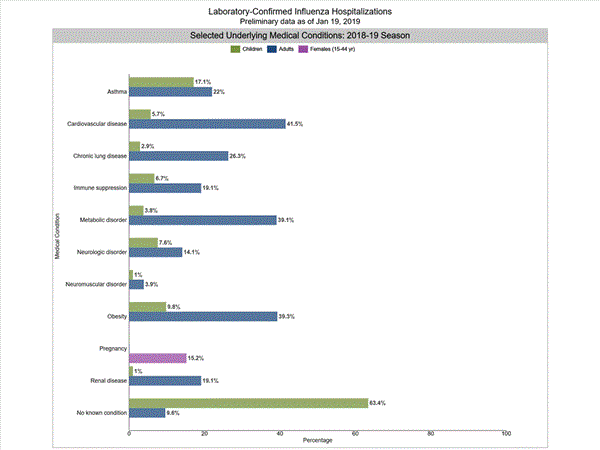
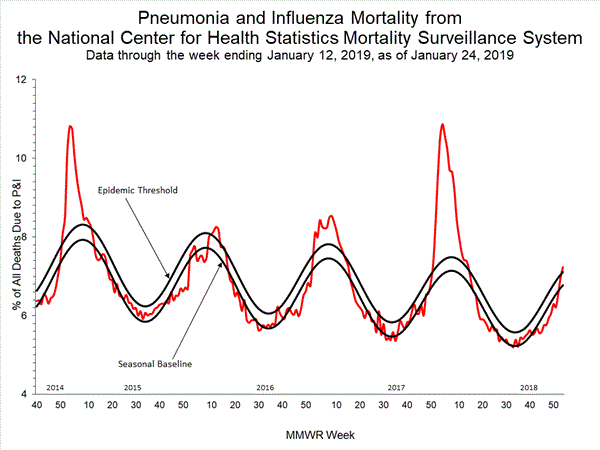
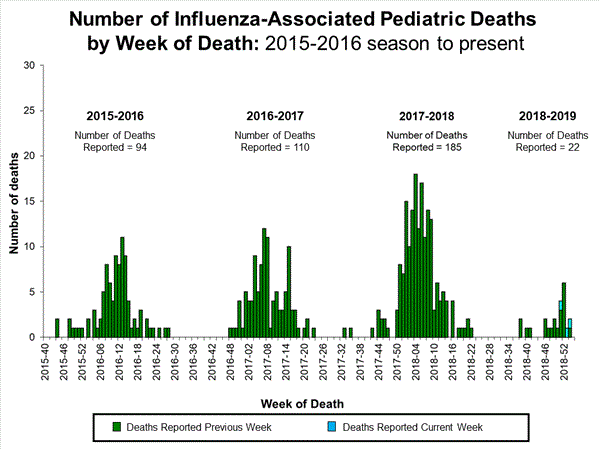
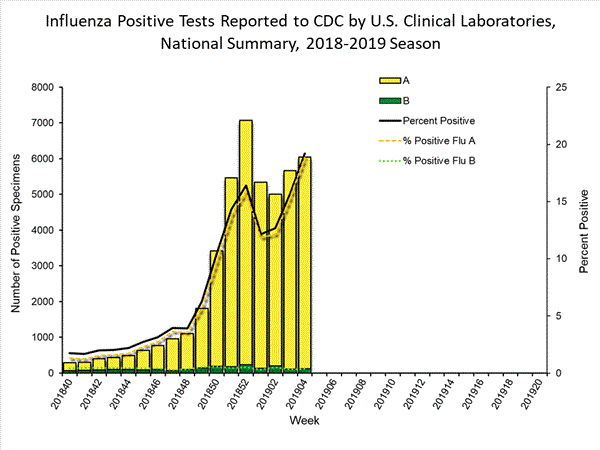
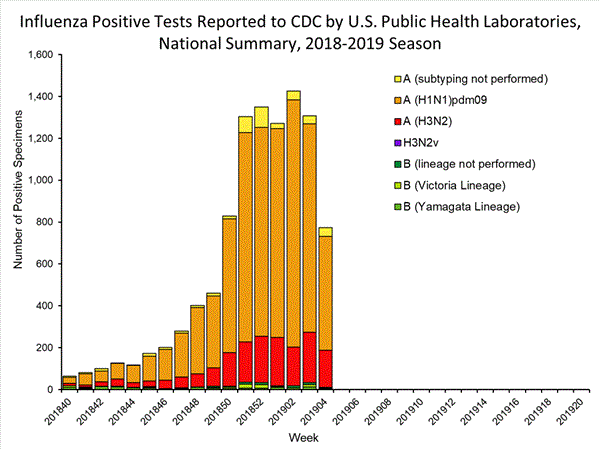
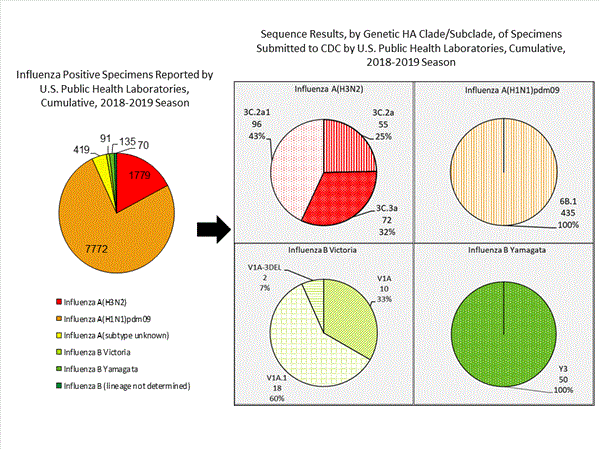
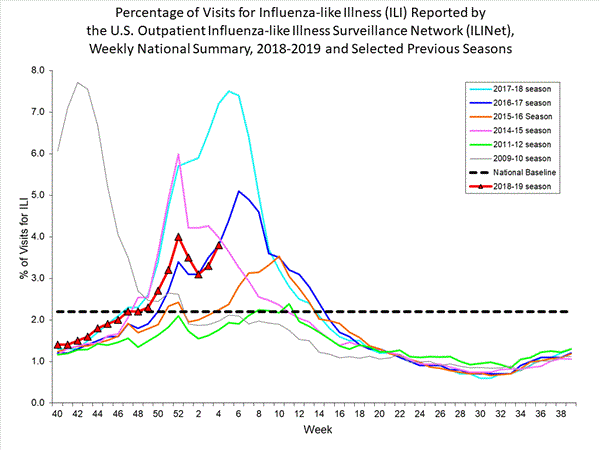
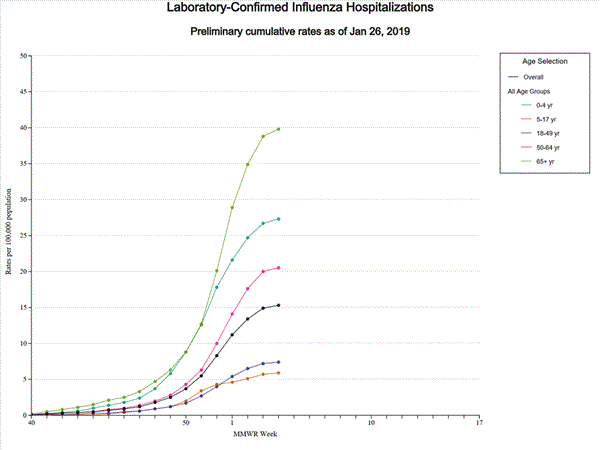
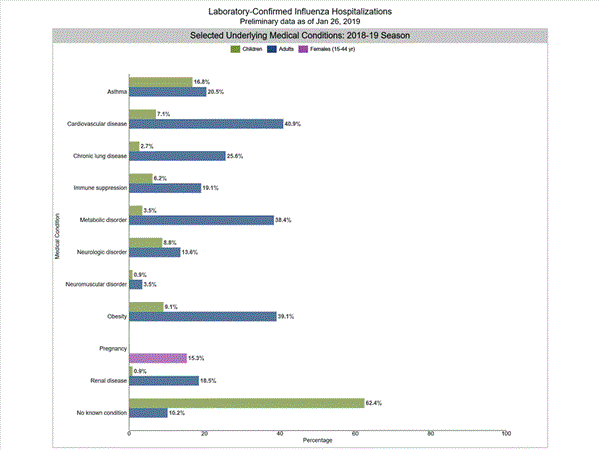
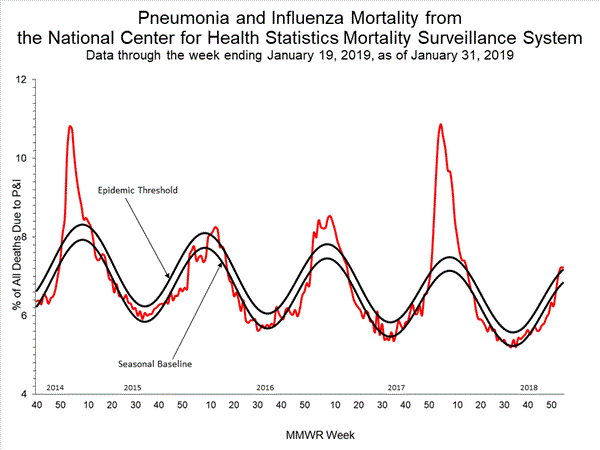
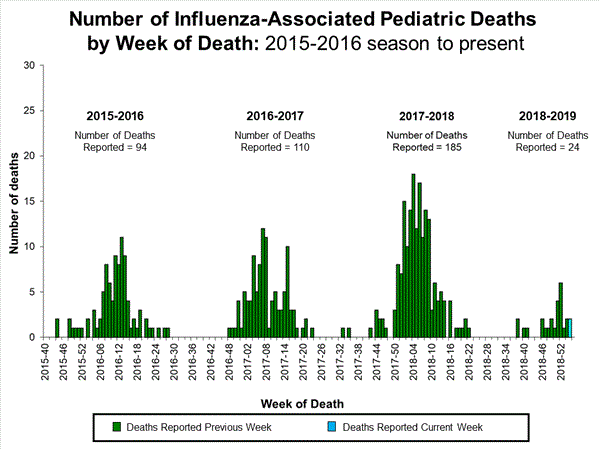
Comment